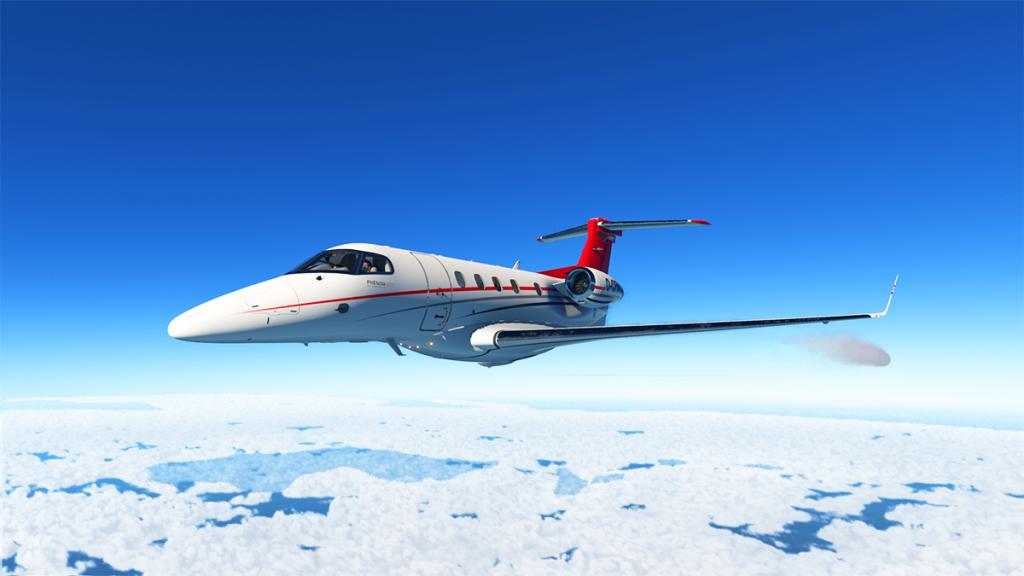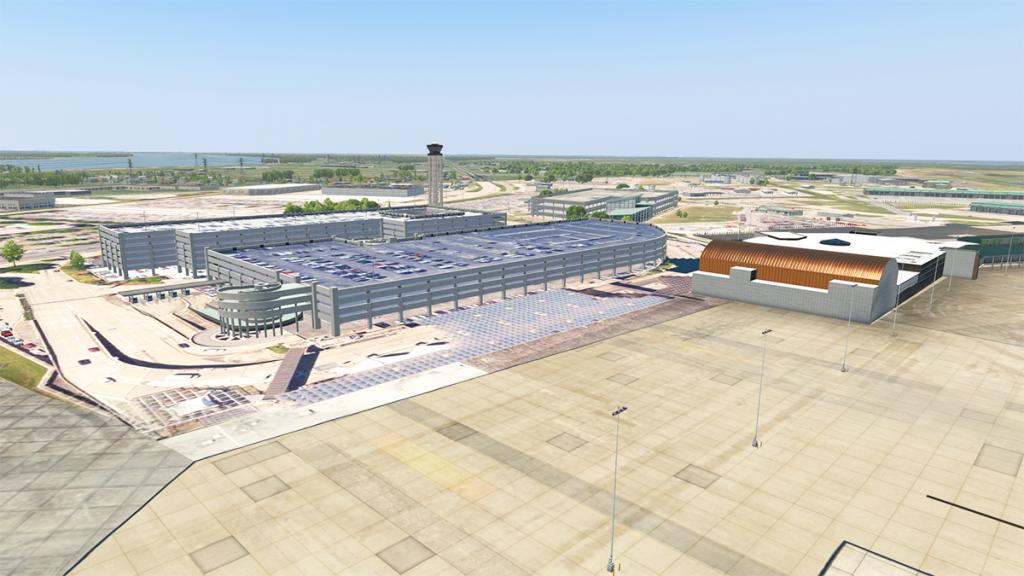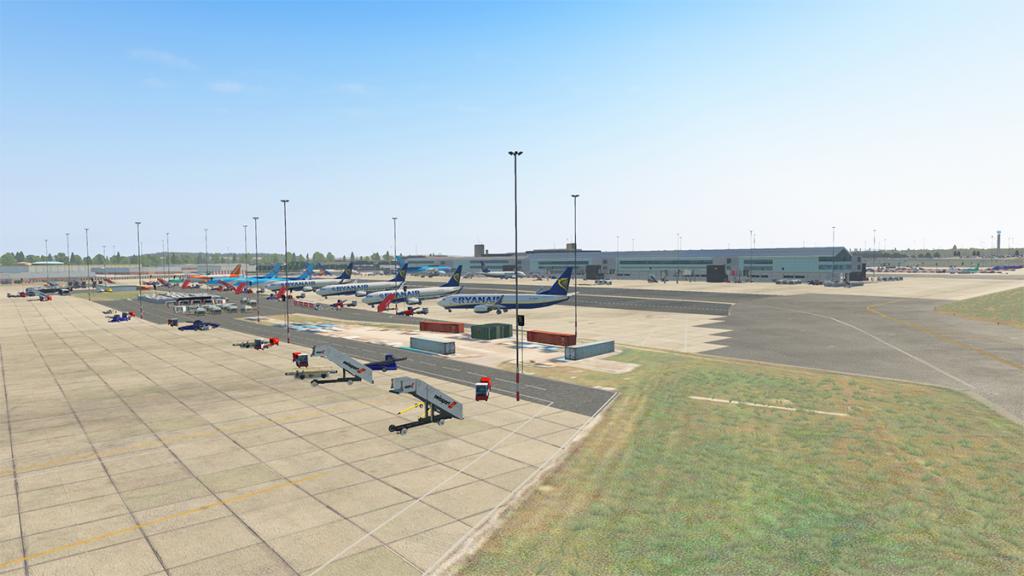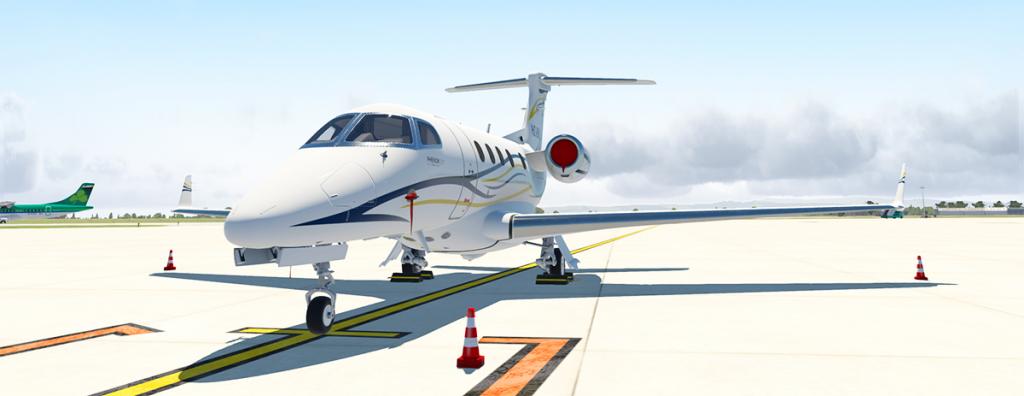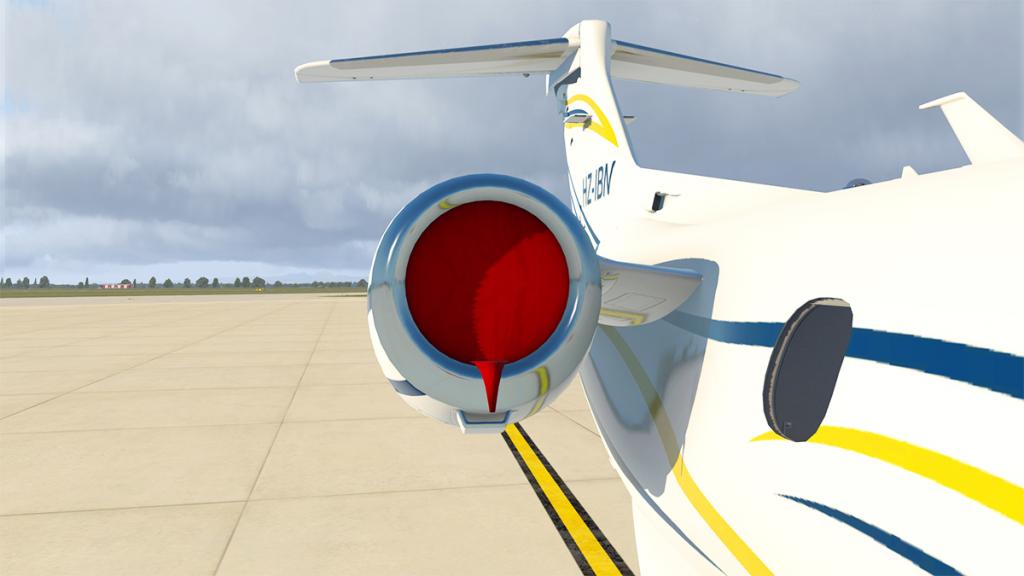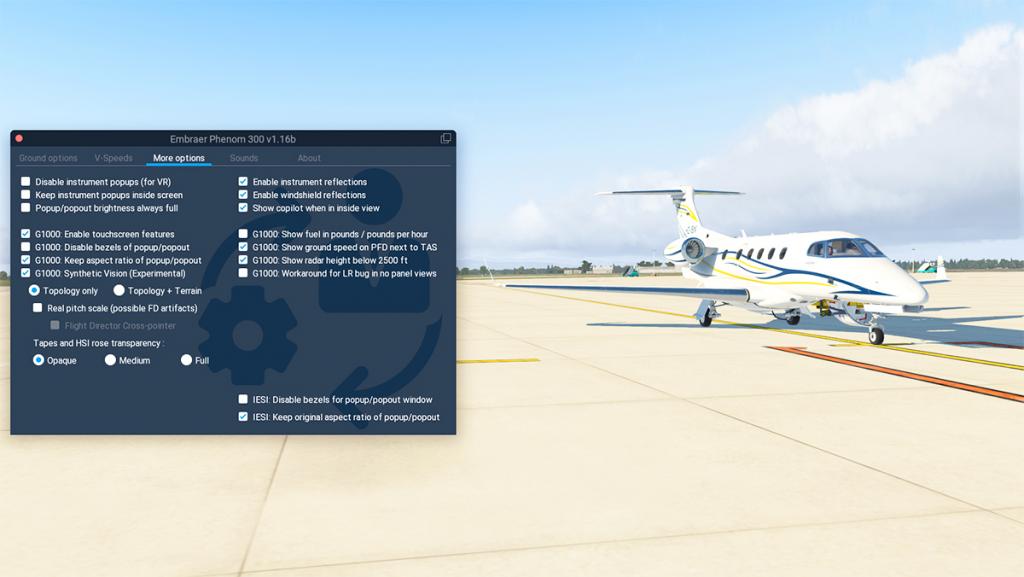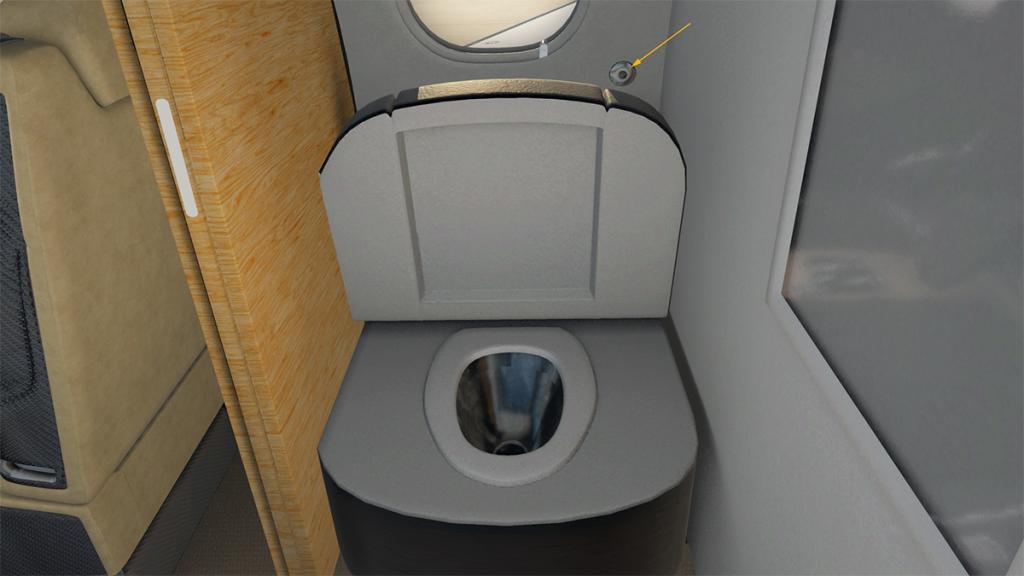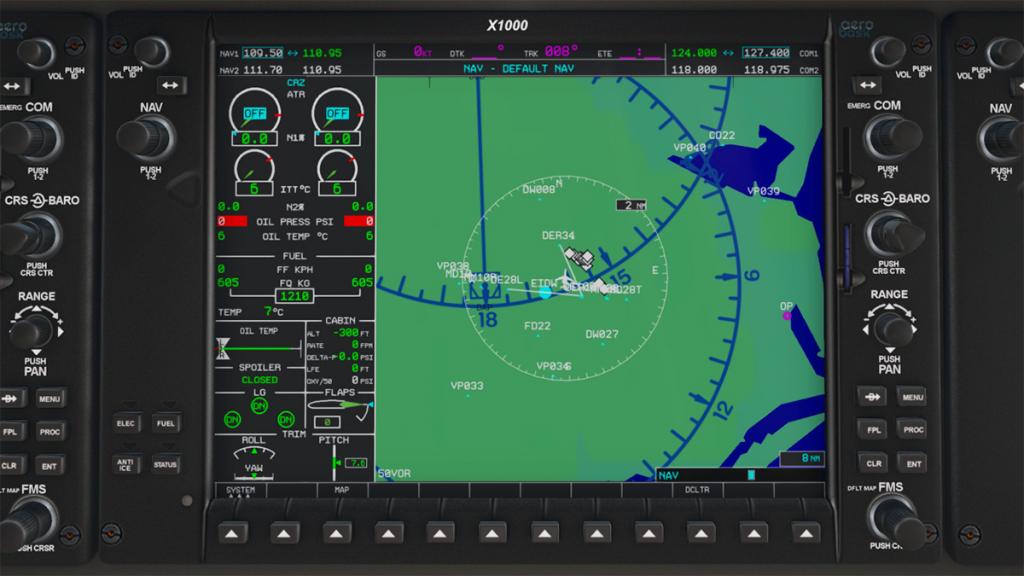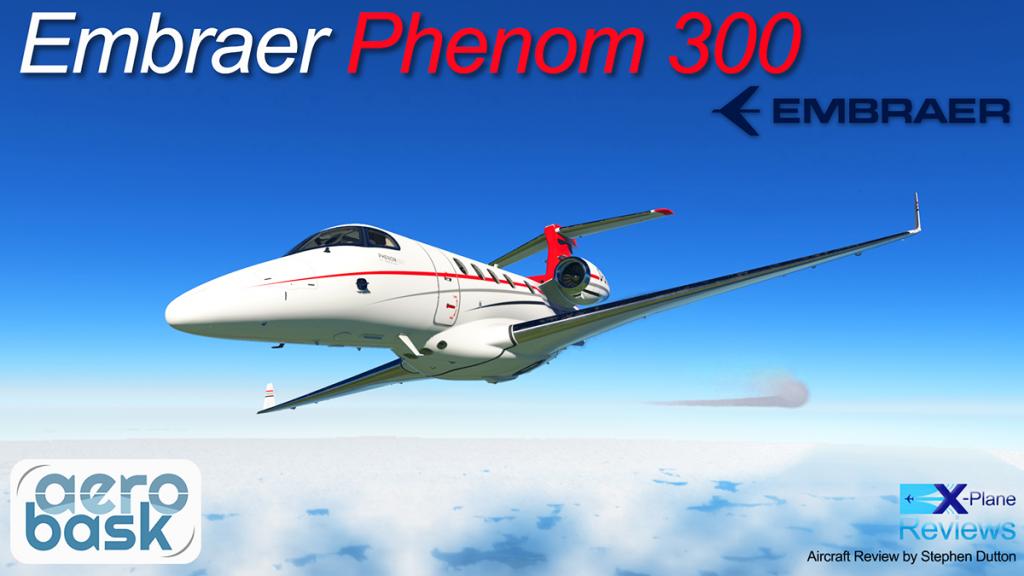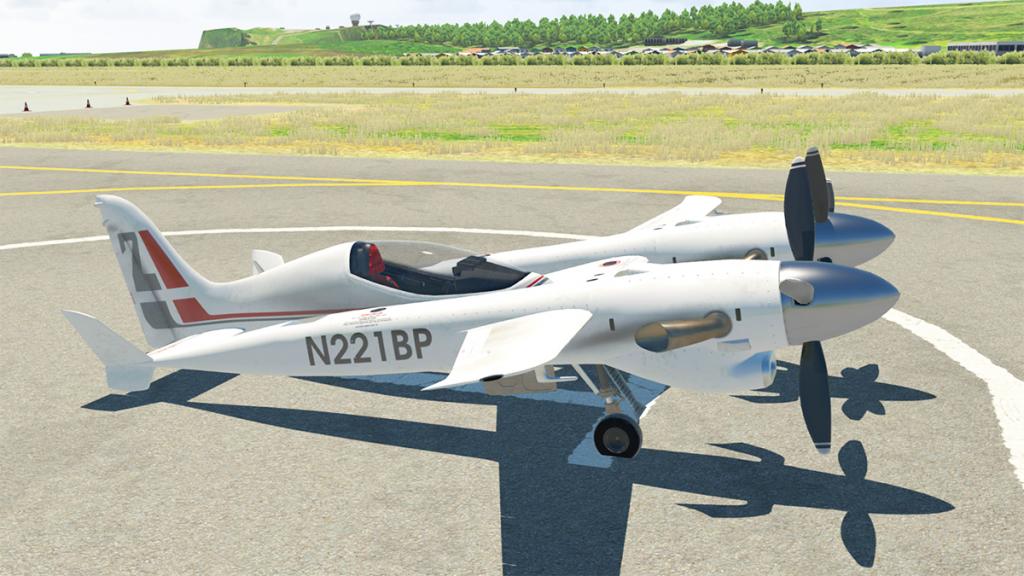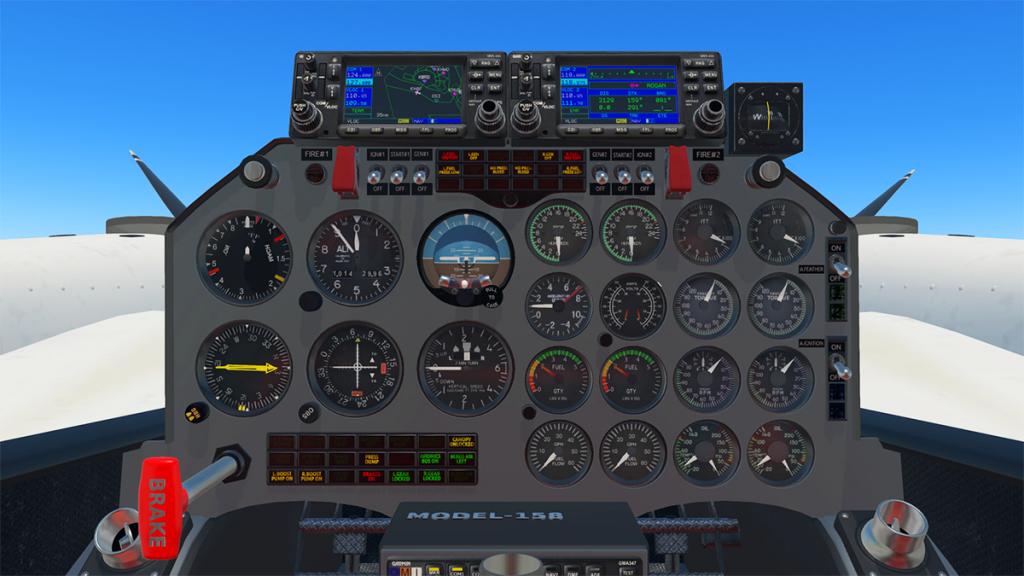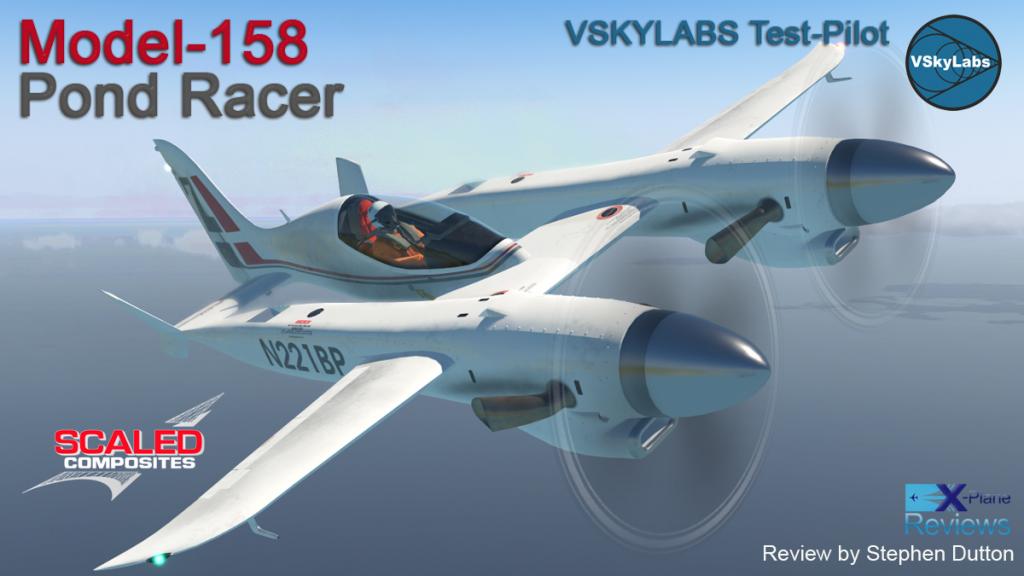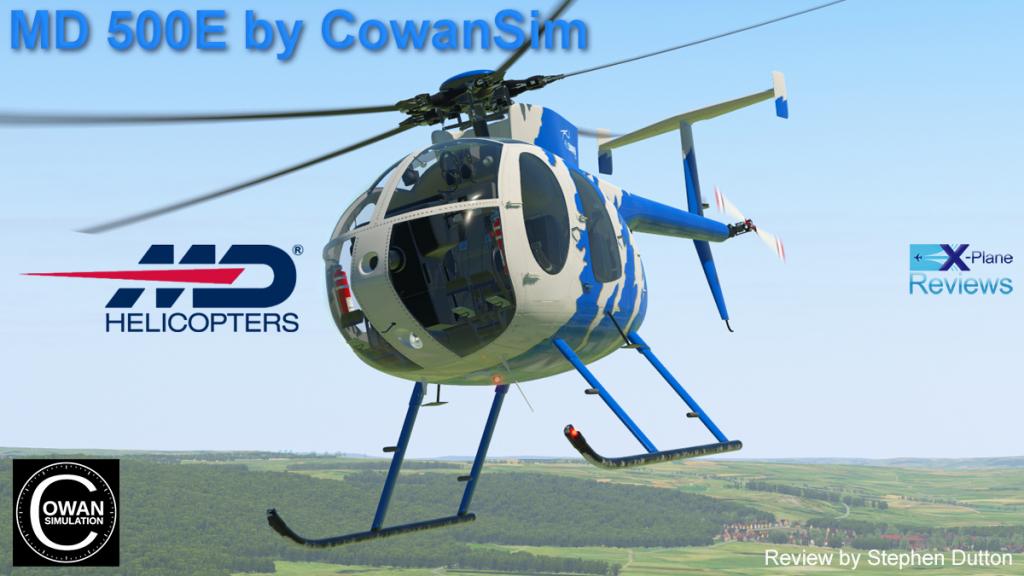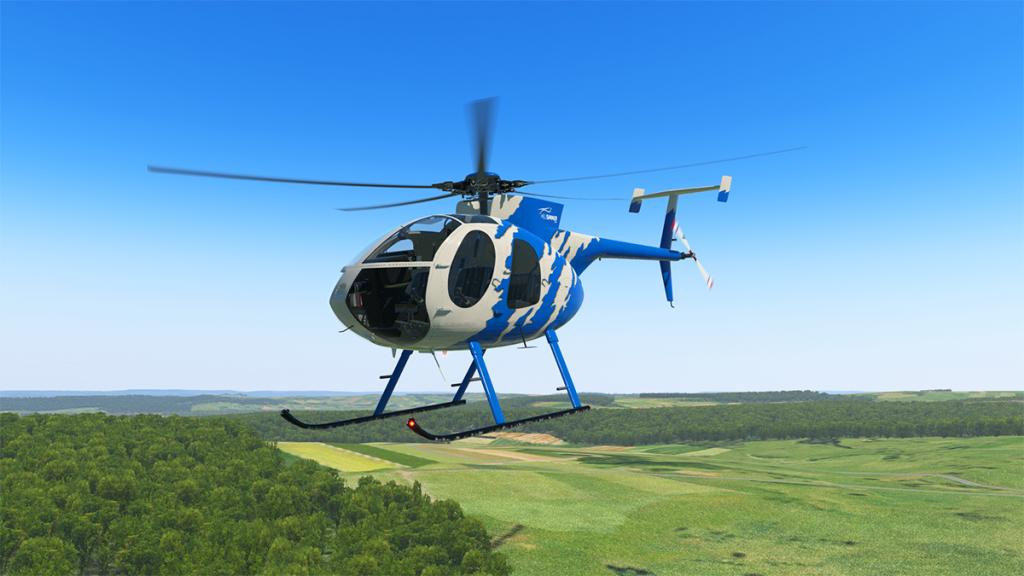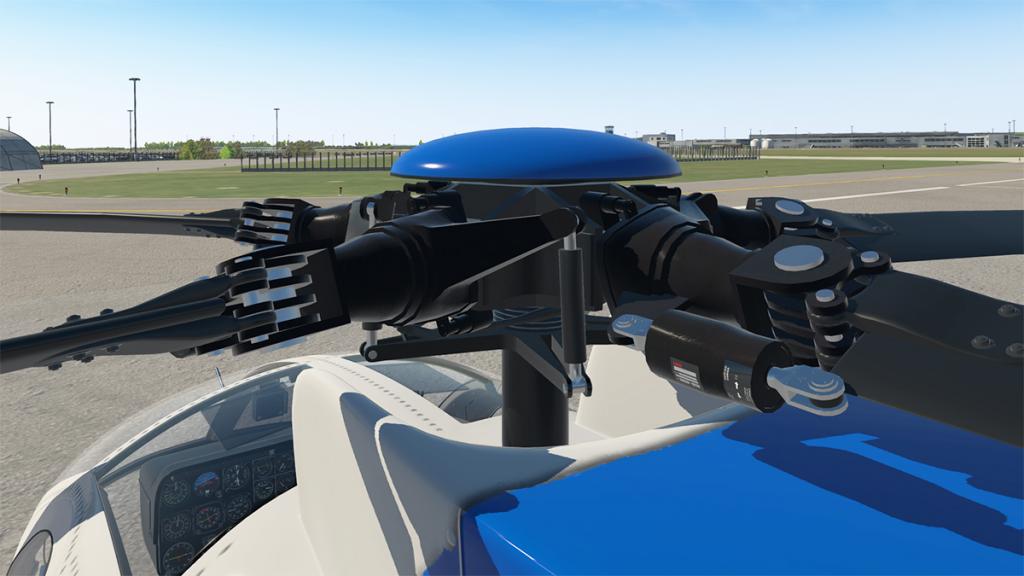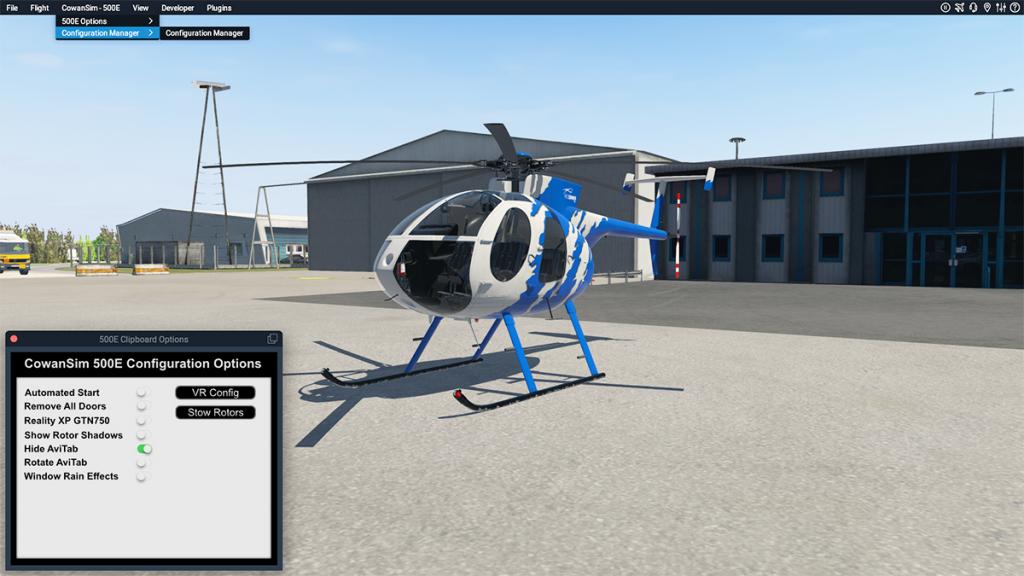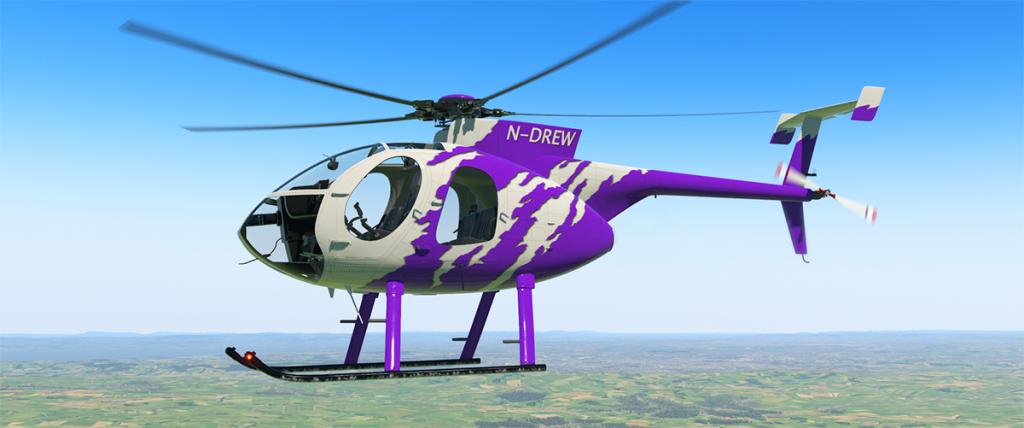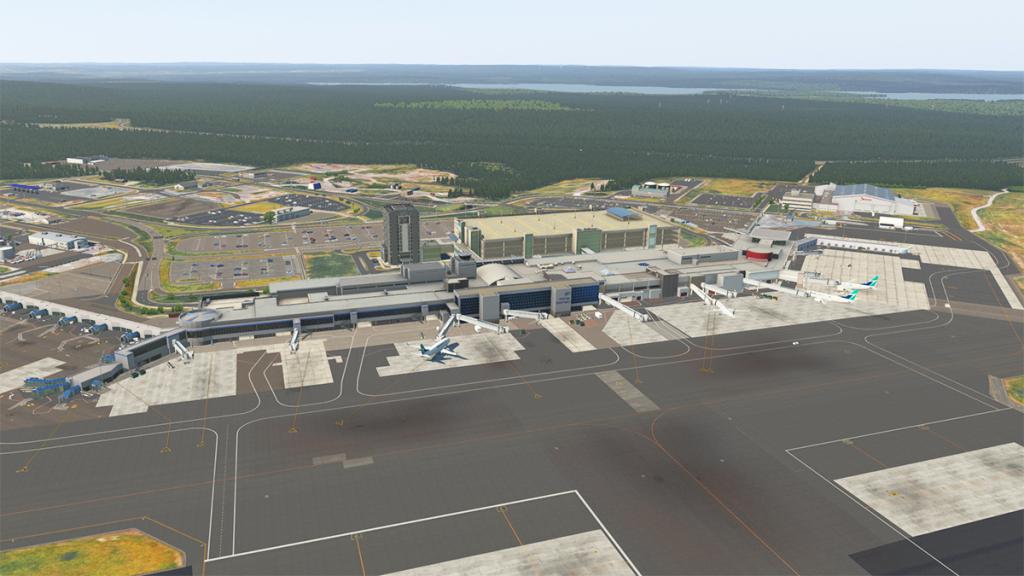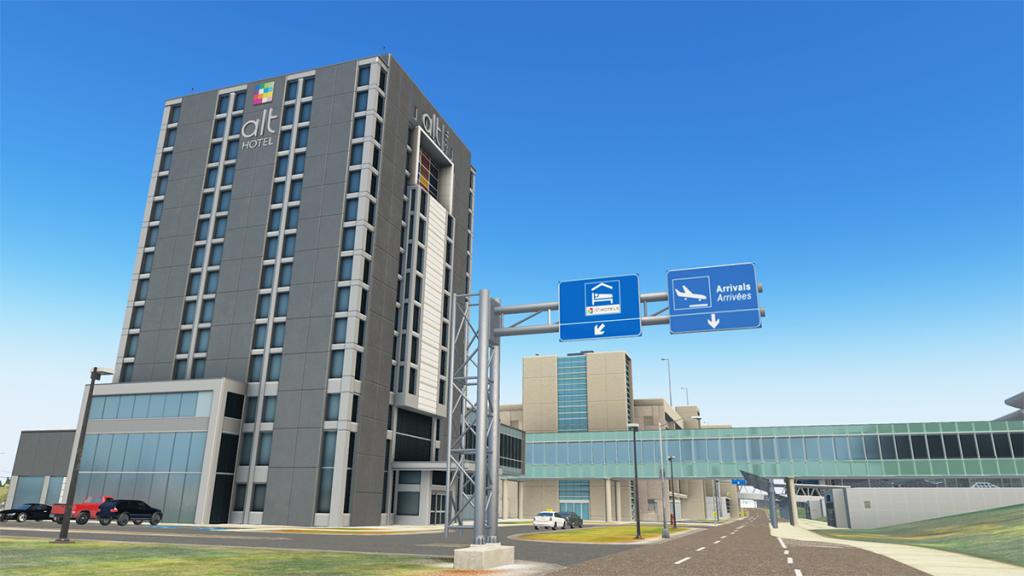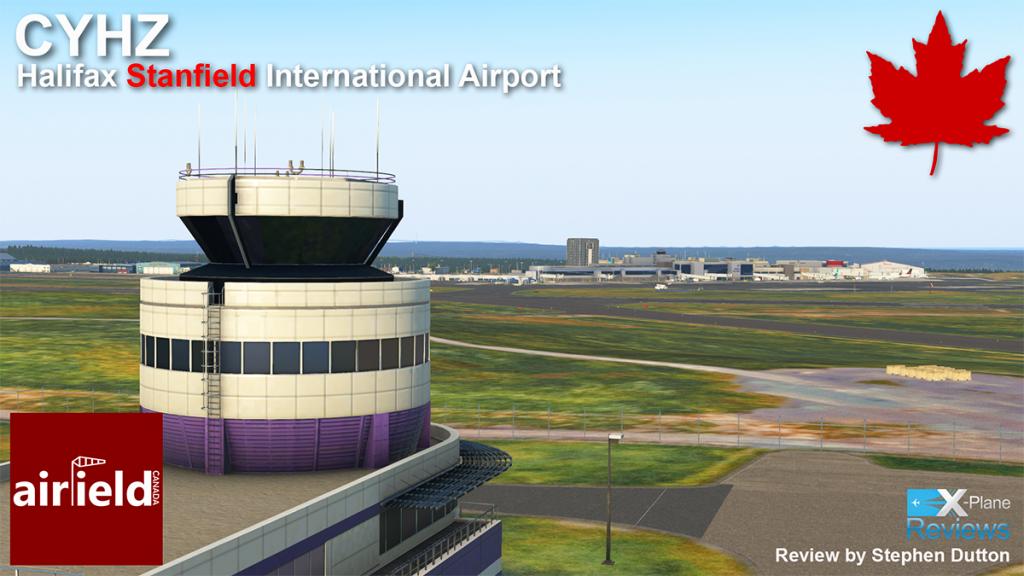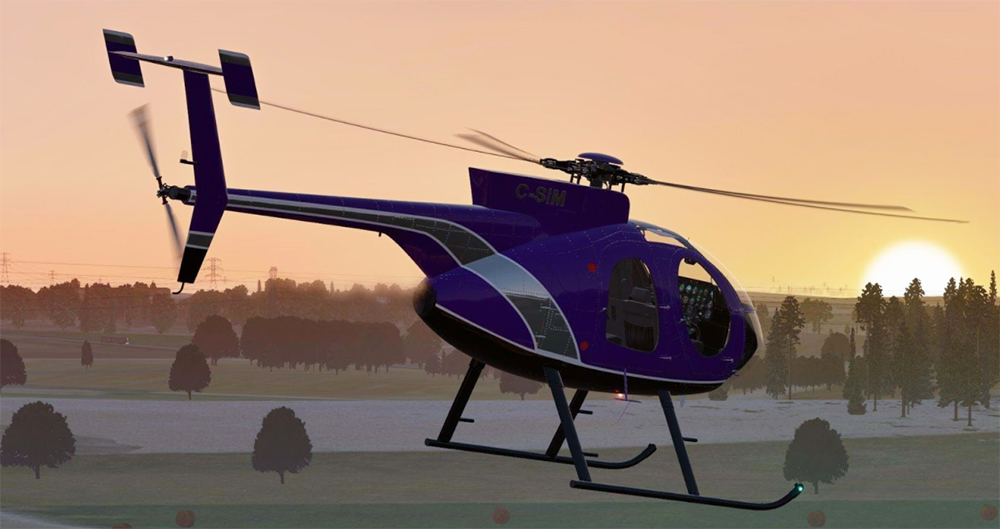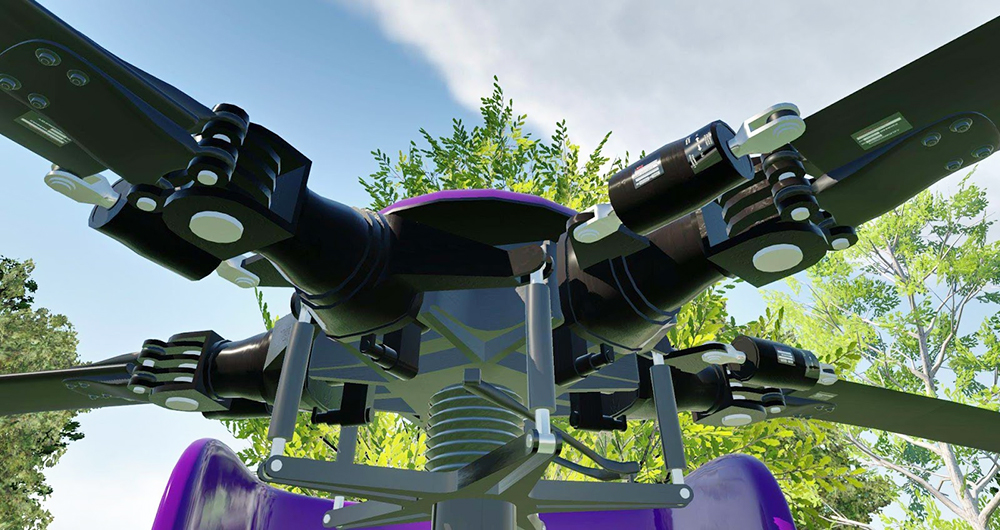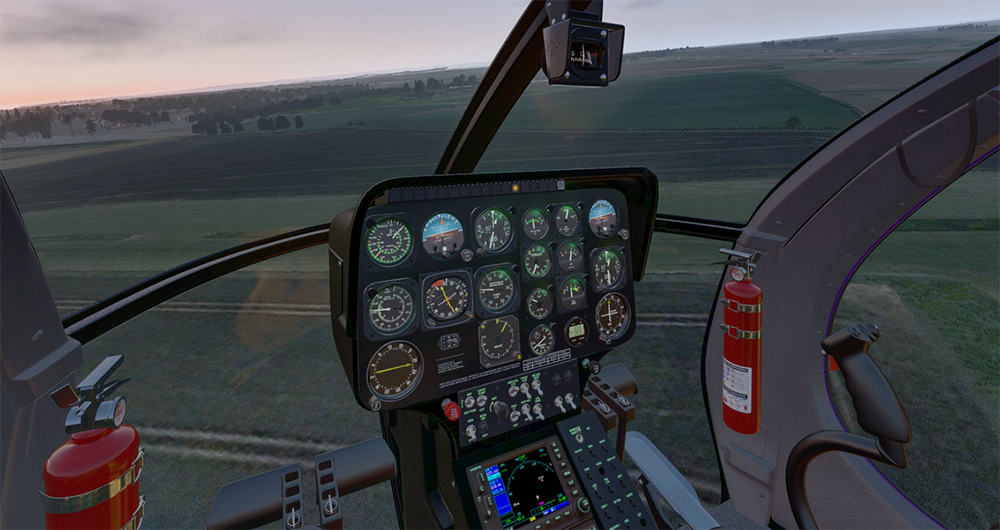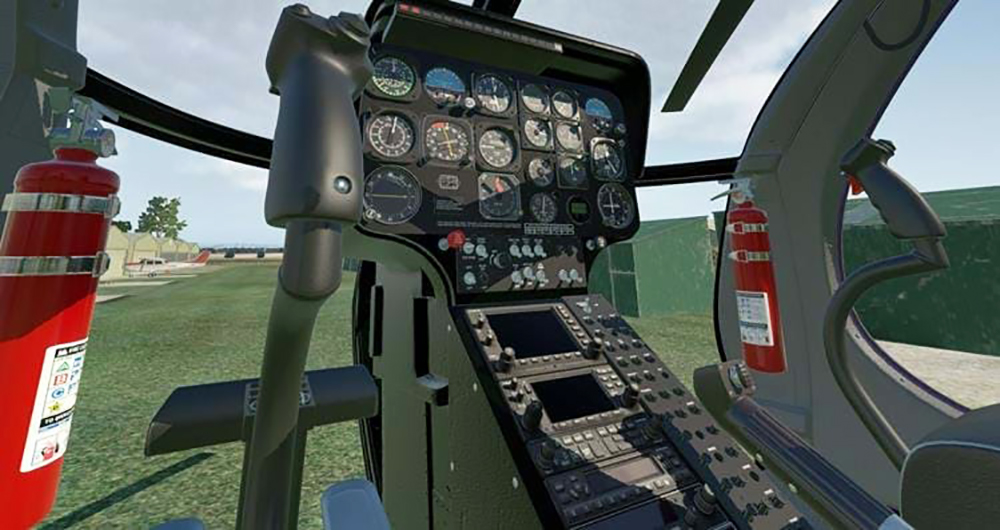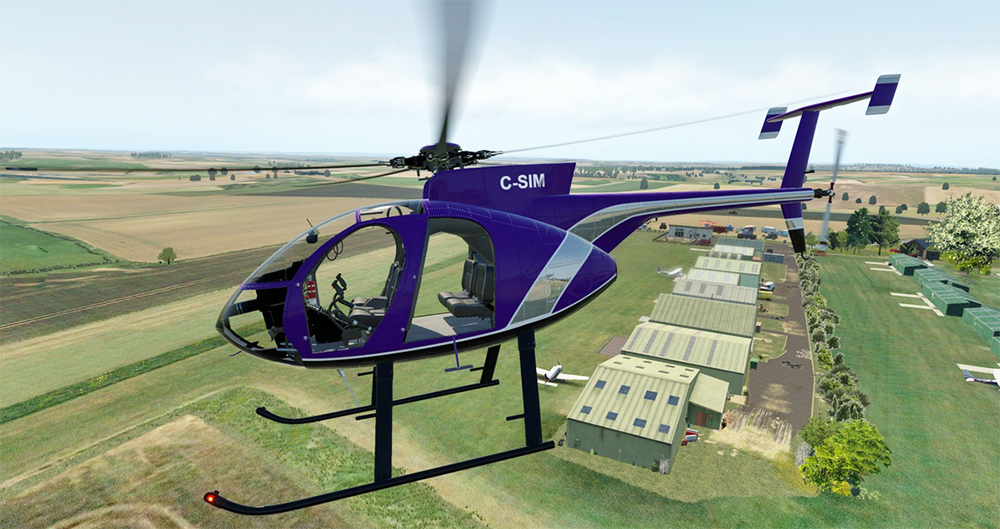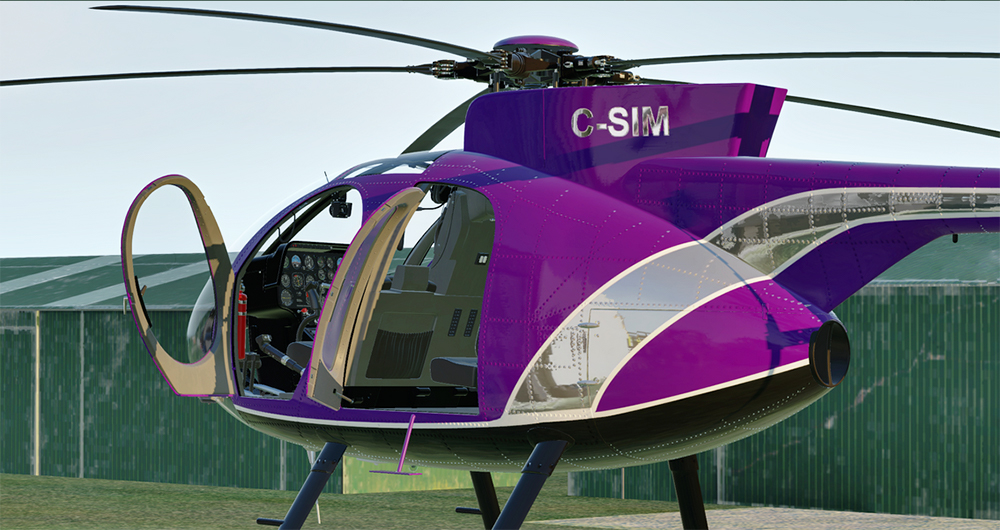-
Posts
2733 -
Joined
-
Last visited
-
Days Won
354
Content Type
Profiles
Forums
Articles
Everything posted by Stephen
-
Hi Fabio, sorry no there is not... the JARDesign A330 is the only one worth flying. There is a RWDesigns Airbus 330-300, with a review here; Aircraft Review - Airbus A330-300 v2 by RW Designs but this is a 2015 design and it does not have failures either. for it's time it was pretty good, there is a A340 coming this year from ToLiSS and that will have a full failure system.
-
News! - Aircraft Update : Phenom 300 v1.1r by Aerobask Certainly already the aircraft release highlight of the year 2021 is Aerobask's sensational Embraer Phenom 300. Just as quick is this post-release update to version v1.1r (not v1.0r, as a few other commentators have noted?). The changelog is quite substantial and covers a lot of (slightly) missed areas. You can update the Phenom 300 by using the built in "Skunkcrafts" updater, but to note to use the updater via loading in first another aircraft. Otherwise you can go to your X-Plane.OrgStore account and redownload the aircraft. Changelog v1.1r Fixed aircraft not working if Aerosoft cycle_info.txt present in Custom Data Fixed holes in cabin ceiling Now supports axis mapping for the flaps lever FLC mode now synch AP speed with actual speed. New option for overriding this Smoother elevator action Put GFC700 IAS/MACH action at proper location Reworked GCF700 textures Fixed PFD lateral mode when new mode engaged after TO New logic for TRIM CAS/aural Fixed GCU477 FPL button animation Yokes now moving with servos Fixed speedbrakes actuators animation Fixed missing strobe and nav spills VR config: fixed fuel switch VR: clickable sliders (but not draggable) Added fictionnal button to force narrow EIS (for using Wide FPL mode) Disabled animation of backup pitch trim when using yoke trim or commands Fixed altitude alert Reduced seepbrakes/ground spoilers efficiency Fixed cockpit lightning New fmod adapted to the some of above fixes X-Plane Reviews have done a through comprehensive review on the Aerobask Phenom 300, here; Aircraft Review : Embraer EMB-505 Phenom 300 by Aerobask And here are just a few images out of the review... Please watch the inserted YouTube video on the review page, as it is a very good detailed overview on how to fly the real Phenom 300 Private Jet. ______________________________ Yes! the Embraer Phenom 300 v1.1r by Aerobask is NOW available from the X-Plane.Org Store here : Phenom 300 Price is US$44.95 Features: - High quality interior and exterior 3D model - High quality PBR 4K textures - Flight model and performances based on the real datas. - Custom FADEC, ATR and Thrust Levers behaviour. - Realistic engine behaviour (as far as XPlane allows us to customize it). - X1000 PFD and MFD from Laminar Research - Custom system pages, EIS, VSpeed and CAS - Synthetic Vision made by Oscar Pilote and Aerobask - Aerobask X1000 TouchScreen feature - GFC700 autopilot with custom CSC mode (FADEC-based cruise adaptive thrust system) + 2D popup - GCU477 (alphanumeric keypad) supporting new LR commands for XP11.50 + 2D popup + physical keyboard on-demand capture - Accurate custom coded IESI with 2D popup - High quality FMOD sounds (recorded from a real aircraft) from Daniela Rodríguez Careri - Full-mode FMOD aircraft - Accurate doppler, distance attenuation and flyby effects. - Enhanced night-time lighting ambience with spill lights for a great rendering - Simulated Stall Protection and Stick Pusher system - Custom Electrical, Bleed Air, Fuel, Pressurization (ECS), Engine Fire and Ice Protection systems. - Avitab support in 3D tablet (requires the Avitab free plugin). - Animated Cabin with Passenger Control Tablet (Shades, Tables, Doors and “airshow” system). - Various 4K PBR liveries and additional 2K PBR livery for low-spec hardware - VR-ready and VR-friendly - Custom documentation based on AFM, POH, PTM and QRH. - Tested and approved by real EMB-505 Phenom 300 pilots Requirements X-Plane 11 Windows, MAC or Linux 4 GB VRAM Minimum - 8 GB+ VRAM Video Card Recommended Download Size: 600 MB Current and Review Version: 1.1r (25th March 2021) ___________________________ News by Stephen Dutton 26th March 2021 Copyright©2021: X-Plane Reviews (Disclaimer. All images and text in this review are the work and property of X-PlaneReviews, no sharing or copy of the content is allowed without consent from the author as per copyright conditions) All Rights Reserved
-
News! - Released : LEBB - Bilbao Airport by Taimodels Taimodels have released their next scenery in the Spanish, LEBB Bilbao. Bilbao Airport is a public airport located 9 km (5.6 mi) north of Bilbao, in the municipality of Loiu, in Biscay. It is the largest airport in the Basque Country situated in northern Spain, with a passenger flow of 5,469,453 passengers in 2018. It is famous for its new main striking terminal opened in 2000 designed by Santiago Calatrava. The unique terminal has a sleek design, with two symmetrical "wings" and a sharp tip at its center which is especially visible when approaching the terminal from the sides. This original design has granted the building the nickname of La Paloma ("The Dove"). White concrete and glass have been used. The interiors are open and luminous spaces, distributed over two floors, the upper one for departures (check-in counters and gates) and the lower one for arrivals. Features Include 4k textures High quality pbr texture on object and ground High performance Completed autogen around airport Autogate Jetways Images are courtesy of Taimodels LEBB - Bilbao International is now available from the X-Plane.OrgStore. ____________________________ Yes! LEBB - Bilbao Airport by Taimodels is now Available from the X-Plane.Org Store here : LEBB - Bilbao Airport Price Is US$17.50 Requirement X-Plane 11 Windows, Mac or Linux 4 GB VRAM Minimum - 8 GB+ VRAM Recommended Download Size: 1.2 GB Current version: 1.0 (March 25th 2021) ____________________________ News by Stephen Dutton 26th March 2021 Copyright©2021: X-Plane Reviews (Disclaimer. All images and text in this review are the work and property of X-PlaneReviews, no sharing or copy of the content is allowed without consent from the author as per copyright conditions) All Rights Reserved
-
News! - Scenery Updated : KMSY New Orleans International Airport v2.0 by VerticalSim VerticalSim have done their first major update to KMSY New Orleans International or giving the airport's full name in "Louis Armstrong New Orleans International Airport". KMSY by VerticalSim was released last year 2020 in late June. This v2.0 update focuses on the nightlighting which has been completely redone from scratch, better lighting in the interiors and field night taxiway lighting (Wig-wags, flashing embers, etc.). PBR (Physical Based Rendering) has also been done to update not only the airport's building surfaces, but also the runway and taxiway surfaces, the Ortho-Photo layout is also new with Color Graded Satellite Imagery. Changelog v2.0 -All new revamped night lighting -Redone PBR on most surfaces -Cleaned up groundtraffic file -All new PBR'd jetways with gate numbers -Better visable interior -Gate numbers marked on ground -Complete new ortho set -Fixed airline assignments -Changed tree color -Add proper night taxiway lighting (Wig-wags, flashing embers, etc.) -New edge lights -New HD Grass (with no performance loss) -FedEx ramp recieved proper night lighting and marshallers -New manual written from scratch -Changed export to target to XP 11.30+ -Fixed Vulkan shadow bug -Fixed AI taxipathing Ground textures are very, very good at MSY. New Orleans City is also part of the package KMSY New Orleans International Airport v2.0 by VerticalSim is now available from the X-Plane.OrgStore. Current purchasers can update to v2.1 by going to their X-Plane.OrgStore account and downloading the new v2.0 version. ___________________________ Yes! KMSY New Orleans International Airport v2.0 by VerticalSim is available from the X-Plane.Org Store here : KMSY New Orleans International Airport Price is US$19.95 Main Features include: 2020 Airport layout Low poly 3D interior Surrounding Autogen Hand Placed High Resolution PBR Ground Textures Sam Custom High detailed jetways Downtown New Orleans Included Animated Sea traffic Baked Ambient Occlusion Animated Ground Traffic Vehicles WT3 Taxi Networks and OPS File 3D animated ground workers Easy Installation Highly Optimized 3D Grass Color Graded Satellite Imagery HDR Lighting *NOTE*: The free SAM plugin is required for this airport to work. You can get it here. Requirements X-Plane 11 Windows, Mac or Linux 4 GB VRAM Minimum - 8 GB+ VRAM Recommended Download Size: 1.7 Gb Version 2.0 (March 20th 2021) ___________________________ News by Stephen Dutton 24th March 2021 Copyright©2021: X-Plane Reviews (Disclaimer. All images and text in this review are the work and property of X-PlaneReviews, no sharing or copy of the content is allowed without consent from the author as per copyright conditions) All Rights Reserved
-

Aircraft Review : Challenger 300 V2 XP11 Captains Edition by Ddenn
Stephen replied to Stephen's topic in Airliners Reviews
No these jets can REALLY climb... 5000 fpm is normal, but most stay around 4000 fpm, the Challenger can climb to FL410 in 18 min, with a 14,330 kg (31,590 lb) weight. Weight and load is the key to getting the right climb rate, If I remember right DDenn provided the links to the data, if not then you may have to go searching for it. -
News! - Scenery Updated : EGBB Birmingham v2.1 by Boundless If any scenery developer has come on in leaps and bounds it is Boundless (pun intended) Simulations. The early work felt a bit rushed, but their latest offerings are now of very much more of a better quality and detail, EINN Shannon in Ireland is a good current example. EGBB Birmingham was one of those early releases last October 2020. And although Boundless has a coming project list that is exciting, they still had the time to review and update this quite newish Birmingham Midland UK scenery, this is v2.1. And a very nice update it is. Focus in the update v2.1 is on getting better performance out of the scenery, by not only reducing the original hefty file size down to under 2Gb (1.89Gb), this was done by improving the ground textures and ground markings, and also adding in great and more local traffic around the Coventry Road (A45) Bypass, and that aspect looks great on approach to RWY 33. Ramp vehicles, equipment and landside vehicles are also now more local and UK branded. Version 2.1 (March 21st 2021) Greatly reduced file size Improved performance Added more detail to NEC area Added custom road traffic (includes UK specific vehicles) Added custom airport ground traffic (real airline / ground handling companies) Improved forests / tree models Improved night lighting Various minor bug fixes applied Improved ground textures Improved ground markings The massive adjoining Birmingham NEC - National Exhibition Centre complex has also had some updates, as has the night lighting. EGBB Birmingham v2.1 by Boundless Simulations is now available from the X-Plane.OrgStore. Current purchasers can update to v2.1 by going to their X-Plane.OrgStore account and downloading the new v2.1 version. _____________________________________ Yes! EGBB Birmingham v2.1 by Boundless is available from the X-Plane.Org Store here : EGBB - Birmingham Airport Price is US$19.99 Main Features include: Full PBR HD custom Ground textures High quality Ortho background Excellent FPS Custom HD Trees Custom Ground Polygons Custom Terrain mesh including the iconic sloped runway (optional) Full PBR HD custom buildings Custom Road signs and lighting Fully accurate night lighting Includes NEC, Resorts world arena, nearby offices and warehouses Fully accurate ground markings, including accurately modelled cracks / wear & tear Enhanced Traffic Global compatibility* Additional PBR water / puddle textures Partially modelled building interiors Custom static ground equipment (Jet2, Swissport etc). Animated monorail (Air Rail Link) All nearby hotels modelled thousands of accurately placed streetlights & roadsigns Requirements Windows, Mac or Linux 4 GB VRAM Minimum - 8 GB+ VRAM Recommended Download Size: 1 GB Current version: 2.1 (March 20th 2021) ___________________________ News by Stephen Dutton 23rd March 2021 Copyright©2021: X-Plane Reviews (Disclaimer. All images and text in this review are the work and property of X-PlaneReviews, no sharing or copy of the content is allowed without consent from the author as per copyright conditions) All Rights Reserved
-
Aircraft Review : Embraer EMB-505 Phenom 300 by Aerobask Traditionally Aerobask are associated with very light, even quirky composite propeller or very light jet aircraft. So it came as a surprise when they announced that their next project was for them an extremely different and a far larger aircraft in the Dassault Falcon 8X, the new flagship of the Falcon range, and an aircraft that can can connect Paris to Hong Kong and Los Angeles to Beijing with no stopovers. Certainly an aircraft that is very far removed for what of anything they had created before. Their Falcon 8X has also been in development now for quite awhile with also a lot of previews and details leaking out about the project... so you would expected a release, well.... soon. Instead Aerobask announced the release of another aircraft in the Embraer EMB-505 Phenom 300, and to a point it is still in the same Private Jet or as we say the "Privileged" Jet category. The aircraft is a size and category smaller than the extreme intercontinental Falcon 8X, but still a huge step up in the other major differences from their other Aerobask aircraft... you could say it is a big and significant stepping stone up to the Dassault, or an intermediate filler, the points to be seen here in this review of the Phenom 300, is what will be also coming in the Falcon 8X, and could also be a noted major sweetener on where Aerobask is now going as a developer. This -300 is not the first Phenom in X-Plane, that release goes to Carenado and the Phenom 100, and like Aerobask they were also taking a next step up from their usual General Aviation single and twin aircraft categories. Oddly I didn't much take to the Carenado Phenom 100, it was slow (really slow for a jet) and it had some really odd and annoying quirks... so overall I passed on the aircraft. So here is the Aerobask Phenom 300... .... the first thing you notice is the quality of this aircraft, as it just leaps out at you, it is not just good, but in a high class of excellence. Everything is so smooooth and contoured. Mapping and NMLs (normals) are excellent, as are all the pronounced areas of the fuselage, and note the rivet work around the excellent metal window frame, the details like the APU vent and lower rudder trim are also really perfectly done. The up-swept wingtip fences are sharklet in shape and are beautifully mastered, intimate detail, like wing screws are also really well done in their details. All aerials and beacons are also well rendered, as are... ... the rear mounted pods that hold the twin Pratt & Whitney PW535E1 turbofans, that produce 15.471 kN (3,478 lbf) thrust each, they are both beautifully proportioned and realistic. Note there is no reverse thrust system on the Phenom. The fuselage concave around the engine mounts is excellent modeling in detail, can't be seen, but to know it is perfectly created for that perfect realism. If you like to gawp at all the lovely work and a lot of detail, then there is a lot of gawping you can do here, the underbody with the built in landing and taxi lights are all excellent, as are all the NACA ducts. The undercarriage is very well detailed as well. You can almost feel the aluminium alloy castings and the way the gear assemblies are held together in their detail. Debatable is that that the castings are certainly well done, but they come with not a lot of wear or tear and grunge, oil or grease on their working parts? but the fineer material detail of all the assemblies is certainly there and are extremely authentic in detail. The main landing gear is a trailing-link arrangement, and all the supports, piping, linkages are all expertly completed, even with the required circlips and pins to hold it all together. The Goodyear tyres are expertly created, with nice shaping with the raised logo/lettering. Hubs and aluminium alloy wheel rims are also first rate. Good glass and surfaces have become the normal now in X-Plane. Even a few years ago we used to do loads of "oohs" and "aahs" at these reflections and the expert depth of glass and nice glossy paint finishes since the introduction of Physically based rendering (PBR), in that models the flow of light in the real world and with the aim to achieve the real effects of photorealism... So externally the Phenom 300 is overall excellent.. but there are a few slight wobbles like around the cabin windows which are not absolutely perfectly rounded, but are modeled more with straighter lines than curves. Before we move inside there are a few details to note in the options on the menu. Menu The popup menu (X-Plane window) is accessed by the X-Plane plugins, and the menu selection is at the bottom, or by pressing the "Aerobask" logo by the IESI. There are Five tabs that cover; Ground Options, VSpeeds, More Options, Sounds and About Ground Options : The ground options page has on the left a Fuel Loading set of sliders, and another for weights of the Pilot, Passengers and their Luggage. Lower are all the aircraft weights of the selections chosen. Right on the page are Ten Selections; Open Passenger Door, Open Baggage FWD LH, Open Baggage FWD RH, Open Baggage AFT, Open Fuel Panel, Camera to Fuel Panel, Open GPU Panel, lower are three options covering Ground Power Unit (GPU), Static Elements and finally you can hide the cabin. As noted you can open/close both front nose baggage compartments, the main access door, and the rear baggage door... Static Elements consist of; Wheel Chocks, Cones, Pitot and Vane covers and engine inlet/exhaust covers... and all of the baggage compartments have a number of cases inside depending on the passenger load. At the rear left there is also an Ground Power Unit (GPU), that you have to switch off the engines and open the GPU Panel to use. Right front wing there is also a Fuel Panel. This is an active panel that can be used to refuel the aircraft, and to get there quickly then select the "Camera to Fuel Panel" selection. There is a Power Switch and the selection of which tank to fill, and to INC (Increase) or DEC (Decrease) the amount of fuel you want in the tank. Finally you remove the fuel cap, and select the "Refuel" switch to start the refueling which is noted above the refuel switch, and the full fuel capacity is 2428kg (5353 lbs), Lamp Test and Shut-Off Test also both work. But there is no external Fuel Truck. The quality of these options is sensational in detail. Pressing the Static Elements "off" will remove the covers and show you the engine fan blades, which are again expertly created. VSpeeds : Second Menu Tab is for the adjustable setting of the vSpeeds, in;V1/Vr, V2, Vac, Vfs and Vref, you can also enable (or disable) the ATR or Automatic Thrust Reserve system. More Options : Third Menu Tab covers the general options of the VR (Virtual Reality), Screen popups, G1000, G1000 Synthetic Vision (options), Instrument Tape transparency (three options in Opaque, Medium and Full), Instrument and Windshield reflections and if you want the Co-Pilot visible in the cockpit, there also two options for the IESI (Intergrated Electronic Standby Instrument) for popout options. Sounds : Fourth Menu Tab covers the sound sliders About : The Fifth Menu Tab covers the people that worked or were involved in the Aerobask Phenom 300 project. Cabin Aerobask always did sensational cabin interiors, so you know it will be something special... as usual they didn't disappoint. Up the stairs and into the cabin, and there is three person sofa on the right side of the aircraft, on the left is a small buffet/galley encased in a nice light wood finish. The cabin has nine seats, the sofa for three as mentioned, a club arrangement for four and two rear single seats. Both tables are animated and when opened, the left has an iPad on a stand and on the right there is a full cup of hot coffee... .... there is an orange juice as well if the coffee is too strong. Each seat has an opening panel that contains two switches to raise or lower the blinds, and switches for the overhead spot light, the blinds can also be raised or lowered by the lever on the lower line of each window. Rear of the cabin there are two in panel doors that can be opened... ... inside to the right is a handwash sink, of which the water does pour out of the tap, the right hand drawer can also be opened to reveal the image of that elusive other Aerobask project the Falcon X8, a sign of a "Coming soon'? On the right is a toilet under a flip up seat... ... when you have done your (um business), then just press the button on the wall to flush! Certainly a first in X-Plane, flushing toilets, god MS2020 users will now get really seriously jealous. And at least you can now use the toilet in flight before landing. Cabin materials and decor is absolutely first rate in quality, this is cabin you would want to spend a lot of time in, and for once in the back. A super nice feature (it does not work unless you have set the Flightplan?). Are two screens on the roof to show the aircraft's position in it's flight profile, the departure and destination airports are shown as is the current UTC time. There are five different cabin fitouts to match the exterior livery (you could also mix and match the interiors if you are so apt). My favorite is the dark wood and light material textures, but all are interesting, and even the lovely abstract patterned carpets change in colour as well. As an option you can hide the whole cabin, if your framerate or computer specs are suffering (that badly?). But to me that is like tearing the heart out of the aircraft and is just leaving it in a big black hole. Cockpit It is usually surprising how small it is in aircraft like these, if you have had the chance to sit in, say a Lear jet then fitting into a small round tube is the feeling. Here in the Phenom the cockpit it is also small, tight and crowded. Cockpit detail is again excellent. You would have been quite disappointed if Aerobask had been a bit shortshifted in here, but it is an extremely nice place to fly and be in this aircraft. In an odd note though, is the curtains don't close, or the armrests are not animated either, which is a given on most of these aircraft. But the cockpit design and as the quality of the materials in here is simply first rate. There is no doubt about that Aerobask feel and look in the design, but here it is all display in a bigger scale and palette than we have ever seen before. The detail and the quality all around you is astounding. Power (external) on and the instrument panel comes alive. Here you have the X-Plane three screen G1000 system, but highly modified by Aerobask. The twin ram-horn yokes can be hidden, but not individually, only together... detail and design of the rams though is excellent. When powering up there is a full system align sequence. The IESI (Intergrated Electronic Standby Instrument) is not just a backup Artificial Horizon, but a full separate system to the main avionics of the aircraft (in other words if everything fails, then the IESI will still (should) work). The IESI displays; Attitude (pitch and roll), Standard or barometric-corrected altitude, Indicated airspeed and VMO Limitation, Indicated Mach number and MMO Limitation, Lateral acceleration/slip indication, Vertical speed, ILS (alignment), Altitude in meters and the Heading. G1000 Avionics The Phenom comes with the Laminar Research G1000 Avionics system, but obviously it also comes with some custom tweaks. It is a PFD - MFD - PFD (Primary Flight Display/Multi-Functional Display/Primary Flight Display) configuration... ... either both the PFD or MFD display can be popped-out either with the Aircraft symbol in the centre PFD, however the pop-out selector can be also quite hard to find on the MFD as it is not positioned like with the central PFD centre aircraft symbol, but it is a touch spot that comes on to the screen in the top centre info boxes for you to select (arrowed). Screens are highly adjustable and you can also hide the bezels (for home cockpit use or for custom setups). I have found over the last few years the PFD and the MFDs have been getting duller, with maybe the reflection effects, but they are and can sometimes be quite hard to see in brighter light. The G1000's PFD main flight instruments are all the standard layouts, with the artificial horizon, speed and altitude tapes, bank roll scale and roll pointer and HSI (horizontal situation indicator), course and heading pointer which are all in one. The FD (Flight Director) elements are also shown. Other features include "Inset" map, alerts, REF/TIMER, NRST, XPDR, both VOR 1 and 2 pointers, DME and Wind (3 options) ... top banner includes Radio NAV (left) and COM (right) Autopilot info (centre). Note the Crew Alerting System (CAS). it comes as standard with the G1000 system, the CAS system of the Aerobask Phenom 300 will display WARNING (Red), CAUTION (Yellow) and ADVISORY (White) alerts, in that order of priority. A few custom features allow you to adjust the radio frequencies directly with a mouse scroll wheel while holding the cursor over the frequency you want to adjust. Another custom pop-out adjuster panel can also be used with the "Altitude" (press arrowed), Heading and Baro pressure and all can be inserted directly from the keyboard for speed... then you just press the green band to insert the number, very quick and easy. A note is that when you use this function, the view movement is frozen (keyboard focus), until you hide it again. The optional Engine Information System (EIS) is available on this version in the PFD in the Emergency mode, selected by the Red button (arrowed bottom left), it also shows the full EIS. MFD - Multi-Functional Display The Multi-Functional Display consists of; Engine Information System (EIS), MAP Functions and Flightplan (planning and execution). Top left shows in systems the ATR Symbol. In the event an engine loses power after V1, an Automatic Thrust Reserve (ATR) feature kicks in. ATR looks for a difference in fan speed of 20 percent or more between the two engines. Should this happen, the thrust of the operating engine is boosted by 5 percent (about 170 pounds), helping the climb rate during the rest of the takeoff profile. Engine Information System has the system pages in having two selections, but the second system option in only changing the Oil Temperature to a "Fuel Calc" (Fuel Calculation) readout, and showing the amounts that can be; Decreased, Increased or Reset. EIS systems shows; N1 (with number readout) and ITT- Inter Turbine Temperature (with number readout), N2 (number only) and N2 Oil Pressure and Temperature readouts, Fuel Flow (FF-Kilo per hour), Temperature, Oil Temperature, Landing Gear Position, Cabin data, Flap Position and finally Roll, Pitch and Yaw Trim positions. MAP, is standard Laminar, but still extremely good in range from 2000ft to 800nm, Options include TROPO and AIRWAYS. Flightplan creation and operation is all Laminar G1000 standard, with PROC (Procedures) for departure and arrival. To date the G1000 is really the standard version with a few nice Aerobask tweeks, but there are also two custom options in this system. The first custom option the set on the MFD lower left of the panel (arrowed), and that is a set of custom coded synoptics pages that are displayed to the Multi-Function Display (MFD). The MFD synoptic indication is designed to provide additional information to the flight crew about the system state and operation. There is an Electrical Page, Fuel Page, Anti-Ice Page and an (aircraft) Status Page,. Synthetic Vision The second custom option is one of the main features of the aircraft, in the Synthetic Vision tool made by Oscar Pilote and Aerobask. You can switch to the original default (below) darker brown and duller blue by turning the Synthetic Vision option off. We will look at the Synthetic Vision and it's features more so in flight. GCU 477 Line Replaceable Unit (LRU) is a “Keypad” based system that provides alphanumeric, softkey, and flight planning function keys used to interface with a Garmin Integrated Flight Deck. On the glareshield is the GFC 700 AHRS-based automatic flight control system (AFCS) The GFC 700 has an odd quirk to be aware of... pressing the ALT (Atitude) button is the way in here to change your speed from IAS to Mach, and not with the usual Speed section which just "Syncs" to the current speed. The HGD (Heading) knobs then syncs to the current heading position. There is also a nice Whiskey Compass positioned on the centre windshield partition. Lower panel has three panels that cover; left - Fuel, Pusher, HYD Pumps (hydraulics), ELT, Pusher and Signs/Belts (seat). Centre - Heating, Ice Protection, TAWS (Terrain Awareness and Warning System) and Landing Gear. Right - Pressurization and Air Conditioning. Lower centre panel covers; Fire, Trim, ENG (Engine) Start/Stop and Engine Ignition Left Pilot side are seven panels; Top is a very nice a functional "Test" panel that covers - Fire, SMK DET (Smoke Detection), Annunciators, Stall Prot (Protection) and Ice Prot (Protection). Next is the Pneumatic panel (bleeds), Electrical (Main and External), Oxygen Mask, Oxygen, Voice/Data Recorder... Audio panel. Right CoPilot side is mostly blank, but has another Oxygen Mask and Audio panel. Centre pedestal/console is quite simple, with the small twin throttle levers, with settings of; MAX, TOGA, CON/CLB, MAX CRZ (Maximum Cruise), note the TO/GO button on the side of the throttle handle. Left top is the Flap position; 0 (up) - 1-2-3-FULL. There is a Speed Brake (Open/Close) here as well. The red pull up handle is the Parking Brake. VR iPad AviTab One feature is the AviTab iPad and it is located in the side storage bin. Obviously created for VR interaction, it is highly useful for the 2d generation as well as It works with the Avitab (Aviators Tablet) plugin. It works quite well in a basic form with mostly for access to stored pdf files and note taking, but internet access would be a nice feature. My use here was with the Navigraph Chart (Subscription) access that is now also available (make sure you have AviTab v0.3.18). The sited just left of the pilot's eyesight, the tablet is very good as is the size in, not to big or too small for ready use. Internal/External Lighting As you would expect the lighting is pretty impressive. The main lighting panel is above the windshield, with the External switches to the left, and the Internal switches to the right. The actual lighting panel is nicely lit for use at night and above the switches is a main cockpit light (dome) that is lit by a button... Between are two spot lights, that you press to turn on, and turn to adjust the brightness... Main instrument and text lighting is all connected altogether, but adjustable... ... Main cabin lighting is also very good. The "Upwash" adjustment is really the overall cockpit and cabin lighting set together... ... but the lighting is highly adjustable to get the right feel. There is also four (above the club seating) lights, that can be activated directly on the roof or by the switch in the seat side console... ... another feature is the "Effect" switch that has three positions; Off/Dim/Bright. This turns on the highlights under the table and on the edges of the console in the club section, and highly effective it is. There is however no lighting in the rear toilet area or the sofa/galley area, so if you want to go to the toilet or wash your hands, pour a drink.. whatever, you will have to ask the pilot(s) to up the main overall lighting. The closed door however does light part of the front of the cabin. Personally I think a few more lights connected to the "Effect", for the front galley and rear amenities area would fill out the cabin a bit more fuller and nicer. External on the ground does have two clever lights on the Fuel Panel and around the rear luggage/GPU area... .... the door entrance lighting is pretty impressive as well. External lighting has the front Taxi/Landing lights that are very effective, but all four underside lights come on for both settings... ... wingtip lighting is sensational. There are the navigation lights (red/green), and a rear white light that lights up the sharket, and all for a nice view out of the cabin. Top and bottom fuselage strobe lighting is also excellent with a nice bright LED effect, but there is no tail lighting or top of tail beacon. Overall the lighting is highly impressive. Flying the Phenom 300 The flightplan today is Dublin (EIDW) to Bristol (EGGD). Passengers are in and the fuel is loaded at 1298.9 kg. Not really a major stretch for an aircraft like this, that has a range of 3,723 km (2,313 mi, 2,010 nmi) with IFR reserves, and we are loaded with five occupants. Starting the Phenom 300 is a breeze, okay... certainly very, very easy. You don't need the GPU actually running to to start the engines, but it does help... Switch up the ignition switch for the selected engine and then turn the "Engine START/STOP" knob to "START" and that is it, just hold the START position until you get a slight "thunk" and the engines start their start sequence. The engines have a Full Authority Digital Engine Control, known as FADEC. So most of the starting, the running procedures and the limits are all controlled electronically, So from a pilot's point of view the Phenom is very easy to set up and start... most actions here are automatic in systems, but there are a few procedures to cover to get the aircraft ready for flight, and they can be found in the Crew Alerting System (CAS), but you will still need to cover the very good and provided checklists to cover them all. Once all the engines are running and settled, then just turn off the ignition switches, then to go, release the park brake and push up slightly the throttles, and it is all as easy peasy as driving a car. Taxiing around airports is also easy as easy, the aircraft is very nice to point and turn, with nice control of the required thrust... ... this is aspect very helpful on busy traffic days, like today at Dublin. Setting yourself up to fly is also easy, as there is nothing else like setting flaps or something, but to simply push up the throttles to just below the MAX... and GO! If you get the yellow bands in the top N1 readout then your throttle setting is too high, so just knick them both back a touch under the N1 100% limit... You can rotate around V2 140knts+10 or 150knts, and the Phenom will simply leap into the air... ... be careful in not over-rotating, as about 12º-15º is perfect, Your climb rate can be as high as a massive 4,000 fpm... ... and the Phenom just climbs up like a banshee, but the aircraft is also very sweet to roll left as you power away from the airport. TO/GA and MAX are the same thing and the only setting that the FADAC system will over-ride the throttle. But beware that MAX Thrust is only intended for Emergency Usage (OEI). As in case of an OEI event detected by the FADEC, the APR (Automatic Power Reserve), if armed, will engage and force the operating engine into MAX Thrust Rating without the need of pushing the Thrust Lever to the MAX Position. Reducing the Thrust to CON will, however, disengage APR and switch back the to CON Thrust Rating. But overall like most Private Jets there is no ATR or Auto-Thrust, so all the power or throttle settings are done manually, the setting CON/CLB is best used for the climbing... There is a full dynamic FMOD soundpack by Daniela Rodriguez Carari, and very good sound it is with accurate doppler effects, distance attenuation and full aircraft flyby effects. The volume externally is quite loud , and I had to reduce the volume to about 25%, internally the Phenom is a pretty quiet quiet machine, because the powerplants are set so far to the rear... in the cabin you get a slightly muffed roar... but acoustically the sounds are very good. The Phenom though is simply Phenomenal looking in the air (pun intended). Maximum Performance is 834 km/h (518 mph, 450 kn), with a Service ceiling of 13,716 m (45,000 ft), which is very high, and the fuel burn is 346 kg/h at 364 kt and 456 kg/h at 431 kt (at FL410). My cruise is set at FL320, or 32,000ft... with the climb over I select the "MAX CRZ " position on the throttle and the Phenom settles down at around 284 knts... ... the Phenom does however have a slight pitch nose down in the cruise, Aerobask say this is normal, but may try to refine the pitch later, but it does not effect the speed, the long droopy nose sort of exacerbates the angle of the look. Synthetic Vision The big feature as noted in the Aerobask Phenom 300 is the Synthetic Vision plugin tool made by Oscar Pilote and Aerobask themselves. This visual system was actually created for the Falcon 8X, but is actually debuted here on the Embraer. Access to the Synthetic Vision as noted is via the Menu/More Options tab. Once activated then the outside heavy cloud cover disappears and you can see all the terrain below, you can select to have just the Topology showing or both the Topology and the Terrain together. It is very similar to the very old X-Plane forward view from years back, but totally refined here into something far more realistic... ... it is also available on the pop-out screen, and both PFD displays. The Instrument Tape transparency over the Synthetic Vision has three options in; Opaque, Medium and Full, and in the end of testing all three, I selected the middle medium transparency as the best compromise, unless you wanted a full external view... A note though. The plugin relies on the X-Plane default textures to show the terrain and runways, if you land or use a custom airport, then once you come off the runway the visual aspect goes to a blank colour, so you have no outside visuals in those conditions, however even in this context the visual look is far lighter and far better that the dark browns and blues of the default Artificial Horizon. The Synthetic Vision is also highly usable at night for following terrain and Topology in the dark. I'll let the very capable Co-Pilot follow the flightplan and have a little rest in the rear sumptuous cabin. Have a cup of coffee and watch the clouds fly by, it is not all heavy work when doing reviews. Anyone that flies Private Jets in X-Plane will tell you the tricky part of flying them is the descent and landing phases. The aircraft itself is nice to fly, but you have to very skilled in the thrust requirements. There is of course no ATH or AutoThrottle, so you have to set or find your own Vref speeds (many are well noted in the manual). In time you will note the correct speeds and throttle settings, the feel of the aircraft's pitch is important as well... but if new to Private Jetting it may take a few or more flights to get expert on the machine in these vital phases of flight... Over South Wales it is time to descend from FL320... if descending around 2,000 fpm, then you will always use the airbrakes as these small sized jets are slippery buggers. The spoilers are also semi-automatic, electrically commanded and hydraulically powered, and they also act as a Ground Spoilers System (on the ground or when landing), Automatic Roll Spoiler (in Flight) and as a manual Speed Brake (in Flight). The "Bank" allowance is shown on the FD (Flight Director), in Full bank it is to the full out side of the marker, a 1/2 bank sits just inside of the yellow inner markers, this is your only indication the "bank" function is actually activated. Down into the low dense cloud below 5,000ft, the Synthetic Vision tool starts to play major dividends, I can see the landscape easily, but the windows are now just a total white (grey?) out... The low cloud breaks out around 2,500ft, but still it is highly misty and you have very low visibility, again the Synthetic Vision is a godsend. More so on this eastern approach into Bristol RWY 27, as there are deadly hills just before the airport parameter, it would be very, very easy to fly too low in the mist and directly into them around Winford. Finding the speed sweet spot on the final approach is tricky? early approach is around 180 knts, then the settings are Flaps 3 and Gear Down, 45% N1 to hold around 130-150 knts. In most cases it is easy to get a nose up (pitch) at the setting you think you need, only to go lower in the speed to get the aircraft correctly posied to land... that speed I found (finally) was around 120 knts, Full Flap... With now several landings under my belt, I have got that approach speed right, but I still have a habit of reducing the throttles too quickly once over the threshold of the runway, just a little slower in reducing the power will give me more lift and a smoother (if longer) landing... ... but, and there is a big but here? As you are very conscious you have no reverse thrusters or any help in slowing the aircraft down once on the ground. So you tend to do the slowest approach and landing you can... Overall though the worry is unfounded. The Phenom does have those auto-spoliers working for you, and the brakes are also highly effective in rubbing off the speed, so the Embraer does actually slow down quite quickly and effectively. Not much flare is required or needed at the last minute either, but your pitch angle has to be right to do so. Note that once I leave the Laminar default textures and move to the custom airport textures, I lose the ground (in this case taxiiway) imagery in the Synthetic Vision (arrowed). You do think about you approach in the Phenom every time after you have landed, and start to work out how to do it better the next time around. Overall it is the only phase of the flight that does require skill, in every other phase the Phenom 300 is very easy to fly. As a note, there is an incredible video to share on a full transfer flight from FTW (Fort Worth) to SAT (San Antonio), I have listed the video below, there is a lot of information in here to learn and practise, to get the full experience of flying the Phenom 300. ______________ Liveries There are ten liveries and everyone is highly detailed and sensational, two are shiny metallics including the N33ZF "Lighting Blue" Default. One livery HZIBN is in both 4K and 2K resolutions. _________________ Summary A full size Private Jet from Aerobask is a step up in scale and design for Aerobask, it isn't the promised Dassualt Falcon 8X, but a category smaller jet in the Embraer Phenom 300, but this aircraft is a huge indication of where Aerobask are going as developers and what to expect from the Falcon 8X when it is released. Aerobask are renowned for their quality externally, but overwhelmingly more for their lavish interiors, and in this respect the Phenom 300 is outstanding in modelling, quality and design. Excellent in all aspects is certainly in it's internal design, the cabin comes with five different interiors or to blank out the cabin altogether to save frameweight. Lighting is also very good, with plenty of internal options, but the galley and rear amenities areas are not lit, but only adjustable with the overall cabin lighting. Notable is the running tap water on the sink and a toilet that actually flushes. Blinds can be dropped, ceiling route display, console controls and coffee and orange juice is also on offer via the folding animated tables. Aircraft systems are excellent. From a fully customised Laminar Research G1000 three display set up, with a IESI (Intergrated Electronic Standby Instrument), GCU 477 Line Replaceable Unit (LRU) “Keypad”, GFC 700 AHRS-based automatic flight control system (AFCS), Automatic Thrust Reserve (ATR) and a Full Authority Digital Engine Control (FADEC) system. The pop-up AviTab tablet is also installed. Main feature is the Synthetic Vision plugin tool made by Oscar Pilote and Aerobask, that allows you to see through cloud or have a visual on the terrain in the dark. The Phenom 300 is very easy to set up, start up and fly, but a little tricky on approach like all Private Jets with no ATR (AutoThrust), but that is also the attraction. The slight nose down pitch is unusual at cruise, but you get used to it. A release from Aerobask is always an occasion, notably for not only the quality of the product, for the list of extensive and spectacular features, but also for the refinement on release. Testing and refining is done before and not after release, so you are purchasing quality and fulfilment in the aircraft from the start and not long, long after your purchase via updates, yes they will be few bugs, but mostly the aircraft is total and complete on release... the built in Skunkcrafts updater will cover those bugs quickly anyway. High quality releases like the Phenom 300 from Aerobask, only come along once once every quarter of the year, so savour this exceptional aircraft and enjoy the freedom of owning your own personal private jet... Highly Recommended! _______________________________ Yes! the Embraer Phenom 300 by Aerobask is NOW available from the X-Plane.Org Store here : Phenom 300 Price is US$44.95 Features: - High quality interior and exterior 3D model - High quality PBR 4K textures - Flight model and performances based on the real datas. - Custom FADEC, ATR and Thrust Levers behaviour. - Realistic engine behaviour (as far as XPlane allows us to customize it). - X1000 PFD and MFD from Laminar Research - Custom system pages, EIS, VSpeed and CAS - Synthetic Vision made by Oscar Pilote and Aerobask - Aerobask X1000 TouchScreen feature - GFC700 autopilot with custom CSC mode (FADEC-based cruise adaptive thrust system) + 2D popup - GCU477 (alphanumeric keypad) supporting new LR commands for XP11.50 + 2D popup + physical keyboard on-demand capture - Accurate custom coded IESI with 2D popup - High quality FMOD sounds (recorded from a real aircraft) from Daniela Rodríguez Careri - Full-mode FMOD aircraft - Accurate doppler, distance attenuation and flyby effects. - Enhanced night-time lighting ambience with spill lights for a great rendering - Simulated Stall Protection and Stick Pusher system - Custom Electrical, Bleed Air, Fuel, Pressurization (ECS), Engine Fire and Ice Protection systems. - Avitab support in 3D tablet (requires the Avitab free plugin). - Animated Cabin with Passenger Control Tablet (Shades, Tables, Doors and “airshow” system). - Various 4K PBR liveries and additional 2K PBR livery for low-spec hardware - VR-ready and VR-friendly - Custom documentation based on AFM, POH, PTM and QRH. - Tested and approved by real EMB-505 Phenom 300 pilots Requirements X-Plane 11 Windows, MAC or Linux 4 GB VRAM Minimum - 8 GB+ VRAM Video Card Recommended Download Size: 600 MB Current and Review Version: 1.0r (23rd March 2021) ___________________________________ Installation and documents: download for the Phenom is 600.00Mb and the aircraft is deposited in the "Aircraft" X-Plane folder. Full Installation is 1.24Gb "AviTab" VR-compatible tablet is required, download is free, and installation is in your X-Plane/Plugins Folder. Documents supplied are: Install_Recommended_settings.pdf Aerobask Phenom 300 Checklists.pdf Aerobask Phenom 300 - Normal Checklist.pdf Aerobask Phenom 300 - Reduced Normal Checklist_2xA5 (1).pdf Aerobask Phenom 300 - Procedures.pdf Aerobask Phenom 300 - TOLD Card kg.pdf Aerobask Phenom 300 - TOLDG Cardboard x4 KG.pdf Aerobask Phenom 300 - TOLDG Cardboard kg.pdf Aerobask Phenom 300 - TOLD Card lbs.pdf Aerobask Phenom 300 - TOLDG Cardboard x4 lbs.pdf Aerobask Phenom 300 - TOLDG Cardboard lbs.pdf Aerobask Phenom 300 - Flight Manual.pdf Aerobask Phenom 300 - Performances.pdf Manual(s) are excellent with full aircraft data, system references, and full checklists and flying tips Support forum for the Phenom 300 FTW to SAT full flight video... ___________________________________ Aircraft Review by Stephen Dutton 23rd March 2021 Copyright©2021 : X-Plane Reviews (Disclaimer. All images and text in this preview are the work and property of X-PlaneReviews, no sharing or copy of the content is allowed without consent from the author as per copyright conditions) All rights reserved Review System Specifications: Computer System: Windows - Intel Core i7 6700K CPU 4.00GHz / 64bit -32 Gb single 1067 Mhz DDR4 2133 - ASUS GeForce GTX 1080 8Gb - Samsung Evo 1TB SSD Software: - Windows 10 - X-Plane 11.53 Plugins: Traffic Global - JustFlight-Traffic (X-Plane.OrgStore) US$52.99 : Global SFD plugin US$30.00 : Environment Engine by xEnviro US$69.90 Scenery or Aircraft - EIDW - Airport Dublin V2 by Aerosoft (X-Plane.OrgStore) US$24.95 - EGGD - Bristol International Airport by Pilot-Plus + (X-Plane.OrgStore) US$22.95
-
Aircraft Review : Rutan Model-158 Pond Racer - Test-Pilot Project by vSkyLabs The bizarre and the unorthodox is littered with examples in aviation, more than really any other medium. Then aviation pushes the boundary on what can and even the unexpected of what has been achieved in relation to leaving the boundaries of not only above the ground but to go even beyond the planet Earth itself. The experimental aspect of flight is strewn with examples that pushed the boundaries forward, but was also the death of many a good pilot... the Model-158 Pond Racer is one such example. First is the name "Pond Racer"... it is not an aircraft designed to fly over water, but the designation is taken by the person who wanted to compete in air-races, Robert J Pond, he also created the Palm Springs Air Museum in California. Bob Pond commissioned the Model-158 design with the idea of developing a modern aircraft that could compete with the vintage warbirds in the Unlimited Class at the Reno air races. Bob Pond was concerned that each year at the Reno Air Races, valuable and historic aircraft were being crashed and destroyed, not to mention many engines being damaged or wrecked beyond repair. The Pond Racer was hoped to be an alternative to vintage aircraft like the P-51 Mustang and the Hawker Sea Fury that would be as fast and spectacular in the air as the warbirds. To do this he turned to the most avant-garde of all the aviation designers in Burt Rutan, and Scaled Composites. The Model-158 airframe was constructed of composite materials, carbon fiber and Kevlar. This resulted in a very light, strong aircraft. And to power the plane, then two Electramotive 3 liter V-6 engines were chosen. These were based on the Nissan VG30 automobile engine. The engines were originally developed for auto racing and were turbocharged to produce 1,000 hp (750 kW). However, those fitted to the Pond Racer only ever achieved a peak of around 600 hp (450 kW). The engines drove 4-bladed propellers via propeller speed reduction units. The result was something out of Star Wars or the racing machines in "The Phantom Menace" episode one of the series. Huge massive twin engines are connected to what is basically a glider cockpit, it flew, and by the results it actually flew very well, but overall it was a flying death trap. VskyLabs has taken liberty with the design, basically it is a reproduction of the original "Pond Racer", but the aircraft is powered by twin PT6A-28 propulsion free-turbine turboprop engines with around the same output (640 kW) as the V-6 original installations. Instrumentation is quite different as well, as the original aircraft quite basic, and didn't have extras like GPS or iPads and all the required complementary systems, providing the needed instrumentation of; environmental control, fuel capacity, navigation-aids and all- weather flying capabilities. The aircraft was fitted with a new type of fuel-system layout, pressurization, oxygen, pneumatic, electrical and avionics. A lot however is original as well, mostly in the aircraft's detail. The design results though are pure Rutan, a very composite aircraft with slender fine forward-swept wing in which the quarter-chord line of the wing has a forward sweep, with slight uplifts at the wingtips. It is a twin boom-fuselage that supports a central rear fine cockpit, in other words a pure racing machine, note the nice upward and downward fins that make the tail really a tri-tail configuration. Brilliantly conceived in you have to admit is in its clever design. Modeling is a mixture of textured and untextured components, and in areas the two do slightly conflict as you can see the differences... But to note first the VSkylab philosophy is that you purchase an ongoing project, so any aircraft that you purchase is not fully completed and 100%, that is the deal you sign up for to get access to the aircraft, all updates to the aircraft are free but the changes however can come infrequently, if sometimes slowly. The landing gear (twin front) is basic modeling, and in parts not even textured, but overall it serves it's purpose in the right links and uprights and in design it is authentic, this is also a tail-dragger aircraft with only a (very) small caster wheel at the rear. A nice touch is the names of everyone involved in the Model-150 are listed on the left and right gear doors. Cockpit is tiny and gliderish in concept, the textured and untextured sections are highly noticeable of the canopy to the tub section. Glass is simply excellent, or would it have been perspex as with the lovely graining on the cover, the canopy shaping is perfect and highly realistic. The highlight on the aircraft is that you can remove the engine covers (press on the covers directly) and then see those awesome PT6A-28 turbines in all of their glory, and they are both amazingly well done. Another nice touch is the fuel tank fillers (four) with two set in the inner connecting wing (21.3 GAL per tank), and two on each outer pod (50.7 GAL per tank), nice tank instructions are noted as well. The Pond Racer has a complex fuel system with the main tanks in the front, and the two pod feeder tanks aft. Cockpit The long thin canopy is opened by a pull rod on the left inner side, and revels a striking interior, highlighted by that padded bright red-orange cushion like seat, a seat is really not what it is, but more a padded material between yourself and the composite frame. The interior detail is both exceptional and realistic, even for an experimental aircraft such as this Pond Racer. Note the blue marks show when the canopy is open or locked. From the external view there is an exceptional pilot in a flight suit, he is also animated to move the stick, throttles and even the rudder pedals. Most of the detailing focus is certainly on the cockpit, as it is really well done. The instrument panel is really quite big for an aircraft of this size and it is also very well fitted out with instruments. I am going to be quite suspect and say the original instrument set up is nothing like this and be quite basic, because the original aircraft was only an experimental aircraft and not a production machine. Top of the panel are two GNS 430 GPS units, which do sort of stick up in your viewline with an attached Whiskey Compass. Below on the panel are the fire switches and starter switches for the left and right engines with the first of two annunciator panels that covers warnings. The Standard Six instruments including the; Airspeed Indicator, Altitude Indicator, Artificial Horizon top, Heading dial with built in VOR Pointers, Course Deviation Indicator (CDI) and V/S Vertical Speed instruments are all grouped together top left of the panel. Below the SS is the second (larger) of the two annunciator panels, this panel covers Systems. Most of the rest of the right instrument panel is taken up by the duel engine instruments and there are sixteen of them (or eight per engine)... top row is the (twin) Propeller RPM and ITT (Inter Turbine Temperature) dials. second row is a G-Meter, Ampreres/Volts and Torque dials. Note you can switch between bus volts and generator load indication via the knob on the Amp/Volt meter. Third row consists of two fuel gauges and RPM dials, and finally the fourth row has (twin) Fuel Flow and Twin Oil Temp and Oil Pressure gauges. The panel looks complicated, but overall it really isn't. There is a box panel beneath that is mostly hidden by the joystick, which can be half-hidden by pressing the base. Top panel is a Garmin GMA347 radio unit, with the external (left) lighting switches and internal Flood and Instrument lighting switches right. Note the exquisite rudder pedals. Top left panel is the parkbrake, Gear lever and twin engine Throttle (black) and Propeller (Blue). Rear panel is a sensational trim section, with nice large wheels to adjust your Yaw, Roll and Pitch trim, with the pitch and yaw noted on the dials. Canopy seal and Firewall shutoff is set mid-panel. Top right panel is the Cabin Pressure gauge, and below your Oxygen Supply (Liters). Mid-Panel top is the Oxygen Regulator, and are controlled by three big switches that cover your Emergency supply (Red), 100%/ Normal (White) and PBG -Pressure (Green). There is a PSI dial for the pressure and a flow indicator. Mid-Panel bottom switchgear that covers Pressurization, PWR (Power/Electrical) and Bleed/De-Ice Systems Rear right panel are the rest of the avionics. There is a S-Tec Forty-Five autopilot, which is odd in a pylon racing machine? but there you go... and a Garmin GTX 327 Transponder... final switches cover the fuel boost pumps. Overall the instrument and system layout is exceptional, and a full description of all the systems including the 28-VDC electric system configuration, that is powered by a 24-volt, 42-ampere hour battery and the two 250- ampere starter generators of the electrical system and the complex fuel system is also well documented in the manual. Also noted in the manual is the full settings for the X-Plane JOYSTICK/KEY ASSIGNMENTS. As the project is designed and optimized for VR (Virtual Reality) usage, therefore, all on- board equipment, switched, lever, handle, knobs and other relevant functions are all accessible through on-screen manipulators, for also use with the mouse in 2D mode, or with the touch controllers in VR mode. X-Plane 11 Experimental Flight Model environment must be ON to fly this aircraft, the checkbox is on the X-Plane/Settings/General menu The cockpit and instrument panel lighting (adjustable) is lovely, the "Flood" light is not a full on bright light, but a nice glow on the panel and underneath it... any side dial is nicely also lit up. STMA AutoUpdater The vSkyLabs aircraft also comes with the STMA AutoUpdater. This tab pops out on the top left of your screen and will update the aircraft version automatically, the same can be accessed via the X-Plane/Plugins Menu. Personally I am not a big fan of this STMA updater as it pops anytime you access this left side of the screen real estate, so (seriously) "annoying" is the word for it. Flying the Pond Racer The real aircraft did not actually taxi... it had a rear wheel puller that positioned the aircraft on the end of a runway, and so that is the best way to start. Starting the twin PT6A-28s is actually quite easy... Boost pumps on, Firewall (Fuel) Shutoff on, Prop levers to full forward, a little throttle. Then Switch up IGN#1 (or IGN#2) and then flick up the starter (START#1 or #2), then above 15% N1 you push in the Fuel cutoff handle. It takes time to wind up and power up the engines, so you have to wait until the Prop RPM is showing around 21x100 percent, before you have fully completed the start procedure. The Model-158 is not at all as noisy as you would expect it to be and even quite smooth, mainly I think it is set with you wearing a full face helmet and oxygen mask... either way it isn't what you expect, but in not being really loud, seriously noisy and rattling your brains out. The view forward is horrible, the view sideways is totally unrealistic... in reality you are flying the machine between the small gap between the font of the pods, al la a Star Wars racer. The sounds are more high buzzy than noisy, but it sounds... well interesting. With the park brake off you gingerly push up the twin throttles, and they require quite a fair amount of throttle to make the aircraft actually move... when moving the Model-158 will immediately pull heavily to the right, I found a way of keeping the racer more on the straight line was to give more power to the right (throttle) engine than the left, it gives you more straight line control... so you steer more with your throttles than with your rudder pedals... you can use the rudder toe brakes if you set them, but the throttle control is more agile in your straight line control... ... the Pond Racer takes a fair amount of time, and runway to gather enough speed for takeoff, part of the effect is caused by you, yourself as in the way you have to nudge the throttles higher and higher while remaining in control, you know with a certain feel, that with just one mistake, it will simply send you barreling off the runway to a certain death. At around 170 knts you will finally have enough grip in the air to fly. The Model-158 will climb out savagely if you let it... there are no official vertical speeds, but around 2,000fpm is pretty close to realistic, no doubt with this much power it could go right off the scale, but let us be realistic here. immediately you are aware that the view forwards is very hard to see with those GNS 430s blocking out the vision, worse is that you need to also see the instruments, and getting (some sort) of forward view and seeing the instruments together creates an odd, if weird viewpoint angle... ... I found very quickly is that the best way to fly the Pond Racer, is actually via the instruments and not so much in the visual, a more head down and level sort of approach. Surprisingly the Model-158 is very nice to fly, the controls are light and the machine is easily trimmed. And very, very fast... Maximum speed is 400.0 mph (643.8 km/h, 347.6 kn), and the real aircraft did achieve that astounding speed. The full history of the Pond Racer makes for unbelievable reading "The aircraft made its debut at the 1991 Reno air races having been flown from the Scaled Composites factory (at Mojave) under escort. Gasoline/Petrol was used as the fuel for the flight to Reno as this gave a greater range. The onboard engine control computers were replaced with equipment for metering methanol in the race configuration. Methanol was the preferred fuel because no intercoolers were needed, and so the associated drag was eliminated. After the day's running had concluded the engines were again configured to burn gasoline/petrol to preclude the corrosive effects of methanol. The aircraft was entered in the Silver class and qualified at 400 mph (640 km/h), flown by experienced test pilot Rick Brickert. The aircraft sadly developed mechanical problems before the race was officially started and dropped out as a DNS. The decision was made by Pond to attend Reno with the same engines used for flight testing. In fact, a vibrator was still attached to the left vertical stabilizer to initiate flutter as part of the planned flight test program. There was no expectation of victory the first year. It was viewed as a "dress rehearsal" more than anything else. After takeoff for the final event on Sunday, the left engine threw a rod out the side of the block and created a tunnel of fire 4 feet (1.2 m) in diameter and about 15 feet (4.6 m) long. An onboard halon extinguishing system put the oil fire out and an uneventful single-engine landing was made. The engine installations were very compact and "close cowled", meaning the bodywork covering the engines had little clearance. The carbon fiber engine cowling was a structural component of the aircraft and as such had to be protected from heat-soak after shutdown. This was accomplished via two 2-stroke weed blowers immediately after the blades stopped turning, quickly followed by two air conditioner blowers attached to the air inlet "scuppers". The engine cowlings were lined with corrugated inconel of .007 thickness. Airflow was vital to structural integrity. Conversely, the powerplant units had to be preheated to nearly operating temperature before the engines were fired up. This was due to the tight tolerances of the engine main bearings. Because methanol burns much cooler than gasoline/petrol, cooling was never an issue. Actually the cold nature of the methanol gave the team a problem with oil viscosity. The thick, graphite laden oil would "puke" overboard for the majority of the time while airborne. Eventually it was determined that the oil drain holes were undersized in the rocker area of the heads as they were not intended to run at a constant high RPM in an automobile application. Fully half of the radiator inlet ducting was blocked off after the first test flight on March 22, 1991. Dick Rutan himself was the initial test pilot. Mike Melvill also flew the plane as did Steve Hinton as part of the test program. On September 14, 1993, the Pond Racer was entered again in the Reno races and once more it was piloted by Rick Brickert. During qualifying, the aircraft began leaking oil and suffered an engine failure leaving the right propeller unfeathered. Brickett pulled up, lowered the landing gear, and chose to perform a belly landing by retracting the gear again. The aircraft then overshot a smooth landing area and crashed in rough terrain, killing Rick Brickert the pilot." (wikipedea) If being cowered down behind the instrument panel is not enough, you can select down by your right seat (arrowed) an "AviTab" VR-compatible tablet, that can be positioned over the twin GNS 430s Now your forward view is completely blocked, so you certainly can't use the AviTab in visual flying. The S-Tec Autopilot is actually very good, but a note to the developer as it is needed in a pop-up panel with it's very hard far right (almost out of sight) position for a more ease of use... The AP will however give you a chance of a rest, and to finally pop your head up for a look around. If you drop the nose too quickly. You do get this weird and very loud helicopter sounding blade slap, authentic? it "scared the bejesus" out of me, so I am not so sure of that one. This machine is created in reality to do only one thing... go extremely fast around a circuit, so ultra manoeuvrability is not the Pond Racer's forte, yes it will turn, climb and go very fast, but you feel you better not push it beyond it's boundaries in case it bites you back in being nasty... just keeping it on the straight and fast is the game on here. Landing takes a lot of skill, and bravery... holding your breath for long periods helps as well. Again trusting you instruments is everything, as the horizon or your view of here the water, can be misguiding to your actual height.... and you can very easily get it all very wrong. You have no airbrake, or flaps to lower your speed? using the huge propellers set at idle can create a drag effect to lose speed, but you have to be careful in not stalling the aircraft... gear down also creates a slowing drag as well. But ultimately you are still going to come in fast... this is what killed Rick Brickert remember. I approach KHAF at 150 knts and 300 ft. The coastal wind is pushing me left as the Pond Racer is extremely lite, but I am holding it, and getting closer to the centreline of RWY 30, I like KHAF as you have a wide runway (meaning lots of space) for these sort of aerial antics. You are extremely aware of those two HUGE spinners on the front of the engine pods, plus the fact you line of view is not quite level either, this creates a sort of abstract view of the ground, in that you dare not put the nose too far down, so you approach in a sort of tail down aspect fear of being too nose down when getting close to the runway. You approach high and super fast, and it take nerves of steel and skill to get this landing right... ... you can easily panic as you feel you are too high, and want to drop the aircraft quicker, but just let it down in it's own time, but also be aware of the X-Plane downward pull, it is severe here, so you have lower your height as you control that sinking rate. Finally the wheels touch, but you are still going fast and furious... ... thankfully the tail drops quickly as does then the speed. VSkyLabs recommend a long runway, and so do I, as you can't touch those brakes heavily unless you want to cartwheel nose over end, but was able to do slight touches of the brakes to rub off a lot of the final speeds. Finally I stopped, took in a lot of oxygen and realised I had survived the landing in one piece... good "plain olde" luck, believe me was part of that landing more than anything else. Personally how could you actually race this thing... it is a deathtrap! External Lighting The Pond Racer is not really an aircraft you would fly at night. You have the three Red, Green and rear White navigation lights, two beacons in a top tail large white and underside red... a large blobby landing light is set in front of the cockpit. Liveries There are only three liveries in the original "Pond Racer" white and red, grey. A Marine Grey and a Red StormChaser livery. A paintkit is provided. ________________________ Summary The famous Model-158 "Pond Racer" was created by the more famous aircraft designer Burt Rutan of Scaled Composites fame. The "Pond" in the name is the as famous Bob Pond, who commissioned the Model-158 design with the idea of developing a modern aircraft that could compete with the vintage warbirds in the Unlimited Class at the Reno air races. It did actually fly in a few tests and in a race, but then crashed and in killing it's pilot, Rick Brickert. vSkyLabs have recreated the racer, and it looks like something out of a Star Wars film. The shape and aerodynamics are perfect, but some liberty was taken in changing the engines from the original (Gasoline/Petrol) Electramotive 3 liter V-6 engines, to a more aviation based T6A-28 propulsion turbine turboprop engines with around the same output (640 kW). The cockpit is also not really an experimental layout, but a more standard instrumentation fitout, with full avionics packs like two GNS 340s, GMA347 radio, S-Tec Autopilot, GTX 327 Transponder and even a popup AviTab tablet. The twin T6A-28 turbine engines are also viewable by removing the covers. Modeling is pure vSkyLabs, very good and not fussy. Internally the cockpit is exceptional. With great materials and instrumentation and even an animated single pilot... so the aircraft delivers a lot, in so little a package. Flying the Model-158 is an experience, even frighting to the uninitiated. View is highly restricted and you have no flaps or speed brakes to get you out of trouble. But there is a real challenge to master the machine and build your skill set on it, overall in that aspect and with it's pure high speeds (400 mph), the Pond Racer is an overall exceptional experience, and good value as well... a final note is that all vSkyLab aircraft are always development in progress (even if this aircraft is far more complete than most), and the purchaser are aware of this handshake deal when purchasing the aircraft. Fast deadly... experimental, the Rutan Model-158 "Pond Racer" has it all... Highly recommended. _______________________________ Yes! the Rutan Model-158 Pond Racer - Test-Pilot Project by vSkyLabs is NOW available from the X-Plane.Org Store here : Rutan Model-158 Pond Racer - Test-Pilot Project Price is US$28.50 Project's Main Features: VSKYLABS 'Test-Pilot' project. Highly defined flight dynamics model of the Model-158. Highly defined PT6 turboprop engine simulation (PT6A-28) including its associated peripheral systems. Built around the powerful, native X-Plane's 'Experimental Flight Model' environment. In-depth systems simulation: Fully equipped aircraft with deep systems simulation (electrical, lighting and warning systems, comprehensive fuel system, fire protection, bleed air and pneumatic systems, ice protection systems, pressurization system, landing gears system, flight control, oxygen system, canopy system, auto-feathering and auto-ignition systems and more). VR (Virtual Reality) Ready. Multi-Layer FMOD sound pack. 50-pages, comprehensive, illustrated Pilot Operations Manual, including checklists. STMA Autoupdater is included: Project updates are fast and efficient! Included Paint-Kit. Highly responsive VSKYLABS support forums. Requirements X-Plane 11 Windows, Mac or Linux 4 GB VRAM Minimum - 8 GB+ VRAM Recommended Current and Review version: 1.0 (March 14th 2021) ___________________________________ Installation and documents: download for the Rutan Model-158 is 285Mb and the aircraft is deposited in the Aircraft" X-Plane folder. Full Installation is 460.60Mb "AviTab" VR-compatible tablet is required, download is free, and installation is in your X-Plane/Plugins Folder. Document supplied is: VSKYLABS Rutan Model-158 POH.pdf Manual is excellent with full system references, aircraft features, and a full "Pond Racer" description and history. Support forum for the Rutan 158 by VSKYLABS ___________________________________ Aircraft Review by Stephen Dutton 18th March 2021 Copyright©2021 : X-Plane Reviews (Disclaimer. All images and text in this preview are the work and property of X-PlaneReviews, no sharing or copy of the content is allowed without consent from the author as per copyright conditions) All rights reserved Review System Specifications: Computer System: Windows - Intel Core i7 6700K CPU 4.00GHz / 64bit -32 Gb single 1067 Mhz DDR4 2133 - ASUS GeForce GTX 1080 8Gb - Samsung Evo 1TB SSD Software: - Windows 10 - X-Plane 11.52 Plugins: Global SFD plugin US$30.00 : Environment Engine by xEnviro US$69.90 Scenery or Aircraft - KHAF - Half Moon Bay by Rising Dawn Studios (X-Plane.OrgStore) - US$19.00
-

Scenery Upgrade : EBBR Brussels v2.0 by JustSim
Stephen replied to Stephen's topic in Payware Airports and Scenery Reviews
Nope don't have that problem... My guess is that you have a scenery order conflict, check the JustSim EBBR is above the Global Airport folder? or there could be another EBBR in there... Stephen -
Aircraft Review : CowanSim 500E by CowanSim There is no doubt that CowanSim has invigorated the helicopter scene within the X-Plane Simulator. A seriously neglected area for years in that X-Plane's mainstay developer in Dreamfoil Creations went very quiet, and that vSkyLab's does only small and very fringe ultra-light machines. So the centre of good helicopters has for years been quite barren. First JRXDesign with their excellent Gazelle SA 341B and SA 342J started the ball rolling again, but it was CowanSim with their very accessible B222B+UT aircraft that has delivered machines for everyone... here is now very quickly in a few months another action packed release from CowanSim in the Famous MD 500E. The aircraft has of course a very varied history and the aircraft comes in quite a variety of guises. Foremost it was the successful Hughes 500 series that began life in response to a U.S. Army requirement for a Light Observation Helicopter (LOH). The Hughes' Model 369 won the contest against competition from Bell and Hiller. The subsequent winner and design became the military OH-6 Cayuse nicknamed "Loach" that first flew in February 1963. McDonnell Douglas acquired Hughes Helicopters in January 1984, and from August 1985 the 500E and 530F were then built as the MD 500E and MD 530F Lifter. But another variant is just as famous and that is the MH-6M Little Bird (nicknamed the Killer Egg) and its attack variant, the AH-6, which are light helicopters used for special operations in the United States Army. Originally based on a modified OH-6A, it was later based on the MD 500E, with a single five-bladed main rotor. Another famous variant is the television star of Magnum P.I., not to be confused with the crappy current 2020 series, but the 1980's series starring Tom Sellick and helicopter pilot (Roger Earl Mosley) Theodore "T.C." Calvin that piloted a brightly (80's) coloured Hughes 500D. This CowenSim version is the civilian MD 500E. MD 500E One thing from the off, is that the MD 500E looks far better in quality that CowanSim's B222. The modeling is much more expertly done and the complex egg shape of the fuselage is excellent, there are still a few untextured items, but overall the 500E shows us a bit more experience in design. Shapes are far smoother, and the finish is more clean, the rivets are well done, if slightly overlarge. They are sadly painted on and come with no raised mapping either, but in context it still works nicely. There are both 4K & 2K PBR Textures, one set for the heavyweights and one for the liteweights, but to be really honest I can't see this aircraft being "heavy" at all on your system, even in it's 4K form, as the aircraft is tiny small. The fine boom tail is excellent as is the glass. The B222 had nice glass, nicely shaped, and beautifully reflective and it is the same here, if better as the glasshouse is quite complex to get right, and it is really well done. Rotorhead Important is the design and actions of the rotorhead. The B222's head was a mixture of okay and not okay. Overall again it is better here in the detail of the complex design, there are again a (very) few not textured links, but most of the rotorhead is modeled black, but it works fine... The hub and blade links are excellent, as is the centre pylon and head, the rubber this time around looks more realistic, but obviously not textured... .... movement in the collective (bite), is again excellent... but the pitch and bank action is however solid at the top, but oddly the lower control disk plate moves... and the movements are not at all however connected to the shock-absorber links? Nasty, so why do that? The tail rotor is far better... shaft assembly is simple but very well done, but again no textures, just the plain modeling, but good modeling that looks realistic. Yaw movements works fine, as the assembly twists perfectly. Both the main rotor blades and rear tail blades are beautifully crafted, and at rest the main rotors droop nicely. The tiny machine does sit quite high on fine skids, and here the rolled skids are well done, with some very nice wear and tear. Doors in all four can be opened manually, or removed completely. Internal cabin and seats are a mixture.. the good is that the seats are really good, and really nice and leathery and authentic to look at with nice inserts... .... they however unlike the B222 don't change colour with the change of a livery, as black with blue piping is all you get... the cabin interior is a bland grey, and it is all not textured either, but straight out of the blender modeling render, it IS well done, but IT IS still basic and drab to look at. Cockpit The instrument panel and pedeestal is quite large for such a small machine... but well done in it's curvy shape and design. The cockpit is framed by the two large red fire-extinguishers, so be careful not to knock your knees on them. Oddly you can hide the right extinguisher, but not the left. Your feet protrude out over the lower glass canopy on four metal plate supports, so the view downwards is exceptional. The instrument panel is oddly aligned to the left seat pilot and not to the usual helicopter pilot position on the right? I tried to fly in the right seat, but too many of the critical flying instruments are set too far to the left to do so, so it is a bit unnerving at first to get used to? Instruments The Standard Six instruments including the; Airspeed Indicator, Artificial Horizon, Altitude Indicator, Rotor RPM N2, Heading Dial and V/S Vertical Speed are all grouped together top left of the panel, lower left is left OBS Pointer, and right a RAD ALT (Radar Altimeter). Right panel has three larger instruments far right to cover (backup) Artificial Horizon, (backup) Altitude Indicator and bottom a Course Deviation Indicator (CDI). Centre right panel is focused on the engine and system readouts. Six dials cover (top) Engine Oil Temp, Engine Oil Pressure, Engine Torque dial, Fuel Gauge (183 Kg), TOT (Turbine Outlet Temperature), Ampreres, RPM N1 and a Davtron M803 digital Clock and Temp panel. Top on the glareshield is a excellent (testable) annunciator/warning panel. All instruments are easy to use and read, but again like the B222 the vital pointer VOR (requirement) is missing, if still there is a useless ADF. Centre pedestal is again quite large and wide for the cabin, there are avionics that includes both GNS530/GNS430 combo top, that can both be replaced with a Reality XP GTN 750/650 Touch optional avionics if you have that product. Center is a Garmin GMA 340 Audio Panel (split for Pilot/CoPilot), Garmin GTX 327 Transponder, Bendix King KR 87 ADF tuner and two COMM/NAV 1- COMM/NAV 2 Bendix/King KX 165 units. Mid-low panel is the electrical switchgear and panel lighting brightness, Avionics power is lower right on the pedestal. There is an optional "Avitab" feature (Menu) that is positioned on the left of the instrument panel. The Avitab can be rotated from the landscape horizontal into the Portrait vertical position... it is however quite small from your seated position, so the position of the protruding tablet makes it hard to read in flight? The cockpit is all glass, but there is a nice Whiskey Compass mid-screen and a OAT gauge, window shades can be moved to your required position, but they are awkward to manoeuvre, unless you are in the right placement to do so. Single headset hangs in the rear, if you click the headset then, then the sounds lower in tone... note the large wall Rotor-Brake. Menus The CowanSim Menu (CowanSim-500E) is selected as part of the main X-Plane menu top left of your screen like on the B222... The list is quite comprehensive with nine selections; Fully Automated Setup, Remove all doors, RXP GTN750 Owner, Show Rotor Shadows, Hide Avitab, Rotate Avitab, Enable Window Rain,Park & Secure Rotor and Set VR Head Position to Current Pos. Note that currently there are no Pilot or CoPilot forms in the aircraft, but they are noted as coming soon? this to me denotes "Not ready" or should have "waited" until they were ready until releasing the aircraft as they are very noticeable in flight by their absence (empty cabin)? There is a secondary "Configuration Manager" which is another word for a VR (Virtual Reality) popup menu. Flying The "Little Bird" CowanSim do provide a startup checklist for the 500E, it is not hard. There are startup notes " The starter button is located on the tip of the collective. The button is programmed to be pushed once, not held in. It will simulate you holding it in so you can manipulate the throttle when 12-15% N1 is reached. There is a click spot floating in front of it so you don't have to change your camera/head position to push it." Basically you turn on the power, then flip up the "Start Pump" switch, release the rear rotor brake and hit the starter switch... Several other starting options include using Ctrl + Shift + E or by using the “Automated start-up” in the upper menu or on configuration popup... Like with the CowanSim B222, the 500E uses the “Wing Sweep” axes instead of the “Throttle” axes for the twist grip throttle while using hardware for a throttle. If you're only using a mouse or VR controller then you can ignore these settings. Make sure you reverse the axes for your collective if you're using a joystick. Another item to learn is using the idle stop ring, which is located on the collective, positioned right at the top of the throttle twist grip. The idle stop ring is designed to prevent cutting off the throttle when at or above ground idle. When starting cold and dark the throttle is cut off. When rolled up, the idle stop ring will pop “in” at minimum ground idle, locking the throttle from being twisted back down. To unlock it simply click the ring and roll the throttle down to cut off. When starting with the engine running the throttle is set at idle for you. Simply roll the throttle into the green to get going. After landing you then rotate the throttle back to the idle stop, then click the ring to roll down to cut off and shutdown. When ready to increase the power you use the “RPM INC/DEC” switch, which can be used to “beeped” up or down the RPM while the governor is active. You can increase to a max of 104% N2 for take off and for landing. 102% N2 is the minimum and 103% N2 is right in the middle of the green and default for normal flight. Like all very light helicopters you have to have an intimate feel with the yaw or push from the tail rotor. That aspect is a given on any helicopter, but more so here. The yaw feel gives the machine it's incredible manoeuvrability abilities, but also has a very light tail feel when in the immediate hover. It is not so much giving the aircraft a lot of left foot rudder, but feeling the pressure of the push of the yaw correctly. As you pull upwards one thing impacts you quickly in that the the Rolls Royce Model 250-C20R/2 450HP turbo-shaft engine behind you has a LOT of power, so you have to use it sparingly. You can easily float quite high and quickly, even while using a minimal collective, but surprisingly you can easily still get back control and move forwards, just keep your control movements tight and small. The aircraft is not as nervy as say a ultra-lite helicopter, mainly because the control feel is so good, and you can soon nicely fall in to the mindset of what you want to do with the aircraft. Very soon I was doing my "700 footers" and was skimming above the ground quickly. The faster you go, then the more that huge dragster racecar T-Tail takes aerodynamic effect, in time you should be able to fly easily with a neutral rudder input, and just use the collective and cyclic movements... You need to use the trim hat switch located on the top of the cyclic. Pushing up will trim the nose down, pushing down will trim the nose up, pushing left will trim roll left and right, right. These can be mapped to your hardware of choice and with the use of the default of X-Plane 11 commands on your keyboard, or in my case on the X56 Rhino Joystick. There is a full immersive sound set was developed with FMOD. And the sounds and animations work together with visual rotor-speed vibrational feedback, rattling, shaking and dynamic blade slap, rain effects... but the blade slap is VERY LOUD, too loud as it drowns out anything else and has you very quickly reaching for your volume button or knobs... sad, as it is very good, but just a bit too overwhelming for being really realistic here... The 500E's performance is very good... It has a maximum speed of 152 kn (175 mph, 282 km/h), and a Cruise speed of135 kn (155 mph, 250 km/h), a Range of 232 nmi (267 mi, 430 km, and a Service ceiling of 18,700 ft (5,700 m), and the Rate of climb is as noted a very quick 2,070 ft/min (10.5 m/s). You have to be extremely cautious on the approach... Transitioning from fast forward flight known as Effectively Translational Lift (ETL), the 500E will very, very easily stall, one minute you are in the perfect approach pattern, then the next you are fighting just to stay airborne? Even being aware of the behaviour, it can still easily catch you out... I lost the 500D several times at this crucial stage of flight. So the approaches and the getting of the correct yaw feel is to be a test of your skill set, it is possible to do, like with any helicopter in with a lot of practise... You feel the pendulum effect quite strongly, and it is your job to control it and your hover, in time you get to understand the aircraft and it's very specific behaviour, and can finally set it down onto it's "daddy long legs" skids. Do I like flying the 500D, always a big question with any helicopter, the answer here is a resounding yes, but I know it will take time to get fully professional in the area of the hover and landing, it is actually one of the hardest to master in this landing sequence... but I am getting there. Lighting The cockpit lighting is very good. The instrument panel and pedestal look gorgeous in the low light, and a nice touch is that the text lights up on the collective... I very much like that. There are two red cabin lights set high up on the rear bulkhead, not that effective in lighting the cabin, but they cast a nice red glow over the instruments. External lighting is of course quite basic, but well done. There is an underbody red beacon, and front landing light... .... a white navigation tail light at the rear, and the two front red and green navigation lights built into the skids are really well done. Liveries There are nine liveries and a white paintkit... all are good, but some of the registrations are a bit, well naff!... I mean "C-SIM"? and worse is that C-SIM is the default livery? Also oddly there is no "T.C." Calvin, Magnum P.I. livery... now that is a big oversight? ________________________ Summary It will be absolutely brilliant!... when the 500D is finished? The MD (McDonnell Douglas) 500E comes from the heritage of the original Hughes 500, also known as the OH-6 Cayuse and the famous MH-6M Little Bird... fame is also from the 80's television series of Magnum P.I. as "T.C." Calvin's Hughes 500, that did the flying over the Hawaiian Islands with Tom Sellick aboard, and "that" moustache. This 500D is CowanSim's second release for the X-Plane Simulator already this year after the earlier and very popular CowanSim B222B+UT The development of this very good 500D has been quick... as this is second aircraft in as many months, but to achieve that there is some compromises. One there is a lot of non-textured modeling, certainly in the whole cabin from the walls, doors and partion, the textures don't have any mapping either and the main rotor plate is not connected to the pitch and bank links and so on.. oh, and the pilots didn't make it into the aircraft either. The manuals are okay, but nothing in depth and in reality it is developed only to a "flyable" condition. For those who like the vSkyLabs sort of development then, they will love this, because you get your greasy little hands on the aircraft sooner than later. Personally, and this goes for CowanSim's B222 as well. I would like more development and the better finished quality of which CowanSim are more than capable of than doing than with these something half-baked aircraft. The aircraft flies amazingly well, and even a total joy to fly and so the basics are right, but you are feeling everything is being done for the market more than producing quality aircraft. And the missing Magnum P.I. livery is just a major oversight on this aircraft. Overall this 500D is a fantastic machine and accessible to most newcomers to vertical flight, but to note it is tricky on the approach and in the hover situations. The Pro's will twirl the 500D around the sky in wild abandon, and absolutely love it, I love it too and totally recommend this MD 500E, but overall CowanSim have to lift their game a little bit to be the serious developer they are more and quite capable of being. Post review note: Please checkout the v1.10 update notes on the 500E aircraft, the many areas noted here are substantially addressed in the later update. _______________________________ Yes! the CowanSim 500E by CowanSim is NOW available from the X-Plane.Org Store here : CowanSim 500E Price is US$24.95 Features: Realistic Flight Dynamics This model has an authentic feeling while exploring the virtual world thanks to Laminar Research for developing a fantastic flight sim. 4k Physically Based Rendering Textures 4k PBR textures, or physically based rendering, provides the ability for very realistic lighting that mimics the flow of light in the real world. This model takes full advantage of X-Plane’s lighting with dynamic reflections and materials. Custom 3D Modeled Instruments Everyone loves a detailed and realistic looking cockpit. After all, that is where we spend most of our time in the sim, flying! The 3D instruments were developed to a high standard and are fully functional, with extensive custom coding to make it as realistic as possible. A Nice Cozy Cabin Sit back and relax in the cozy rear cabin and enjoy replays of your flight from a passenger’s perspective! Was it as comfortable and smooth as you thought it was from the pilot seat? This is especially interesting in VR and landing replays are the best. Paint Kit & Liveries Comes with several liveries and we also included a detailed paint kit. The kit is provided in both GIMP and Adobe® Photoshop® formats. A UV map layer included in each file allows for easy and accurate repaints. Vibrant and Detailed Night Lighting X-Plane has wonderful night lighting. The 500E project aimed to have plenty of lights, inside and out, making night flights possible. From the landing light to the cabin lighting, this helicopter really stands out at night. Animation & Sound Thousands of lines of custom code make up animations and systems. The fully immersive sound set was developed with FMOD. Sounds and animations work together with visual rotor-speed vibrational feedback, rattling, shaking and dynamic blade slap, rain effects and more. Reality XP GTN 750 Integration The Reality XP GTN 750 is fully integrated into the cockpit. Reality XP GTN 750 Touch is the genuine simulated device used by flight simulation enthusiasts navigating the virtual skies as well as real world pilots for familiarization with the device. This add-on is a payware add-on and you can purchase it here: Reality XP 2K & 4K Versions FMOD Fully Dynamic Sound Pack Window Rain Effects Compatible with Vulkan API Virtual Reality Ready AviTab Integration RXP GTN 750 Integration Customizable Configurations Realistic Flight Dynamics 4K & 2K PBR Textures Custom 3D instruments Detailed Night Lighting xLua for Systems and Animation SASL v3.12.1 for Custom Plugins Requirements X-Plane 11 Windows, Mac or Linux 4 GB VRAM Minimum - 8GB+ VRAM Recommended Download Size: 570 MB Current and Review Version: 1.0 (13th March 2021) ___________________________________ Installation and documents: download for the 500E is 570.40Mb and the aircraft is deposited in the "Helicopter" X-Plane folder. Full Installation is 1.15Gb Documents supplied are: CHECKLISTS - START-UP - 500E.pdf MANUAL-500E.pdf Manual is half completed with no instrument references or just basic system references, checklist is very good. Support forum for all helicopters by CowanSim ___________________________________ Aircraft Review by Stephen Dutton 16th March 2021 Copyright©2021 : X-Plane Reviews (Disclaimer. All images and text in this preview are the work and property of X-PlaneReviews, no sharing or copy of the content is allowed without consent from the author as per copyright conditions) All rights reserved Review System Specifications: Computer System: Windows - Intel Core i7 6700K CPU 4.00GHz / 64bit -32 Gb single 1067 Mhz DDR4 2133 - ASUS GeForce GTX 1080 8Gb - Samsung Evo 1TB SSD Software: - Windows 10 - X-Plane 11.52 Plugins: Traffic Global - JustFlight-Traffic (X-Plane.OrgStore) US$52.99 : Global SFD plugin US$30.00 : Environment Engine by xEnviro US$69.90 Scenery or Aircraft - EGGD - Bristol International Airport by Pilot-Plus + (X-Plane.OrgStore) US$22.95
- 5 replies
-
- cowensim
- hughes 500e
-
(and 2 more)
Tagged with:
-
News! - Released : Rutan Model-158 Pond Racer - Test-Pilot Project by vSkyLabs The Rutan Model-158 was a twin-engine racing aircraft, developed by Burt Rutan (at his company 'Scaled Composites'), for Bob Pond (1924-2007), a honorable aviator and inventor, to be flown at the Reno Air Races back in the early 90's. The Pond Racer's made its first public appearance at the Reno Air Races in 1991, but dropped out due to mechanical problems. On September 14th 1993, during qualifying, the Pond Racer, which was piloted by Rick Bricket, crashed following engine failure, killing the pilot. The crash of the Pond-Racer ended its development. The VSKYLABS Test-Pilot: Rutan Model-158 Project introduces a plausible aircraft variant, based on the original "Pond-Racer" aircraft. Initial project's objective was to explore the Rutan Pond-Racer aircraft design features, estimated performance and flight envelope using X-Plane flight simulator as an advanced flight simulation lab. The second objective was to design a plausible variant that extends the Pond Racer usability as a racing aircraft, to an all weather, cross-country sport plane. The VSKYLABS Rutan Model-158 variant is an advanced flight simulation model of a high-performance turboprop aircraft, capable of flying approximately 1.5 flight hours up to ~30,000 feet while cruising and can cover more than 500 nautical miles in a single flight. As with all VSKYLABS projects, actual and relevant real-life pilot-experience had a major part in the design, development and test flights process. In this specific project, several aspects of the aircraft had to be addressed or to be designed from scratch, to allow all required systems simulation and integrations. The core of the project is a highly defined flight dynamics and PT-6A propulsion model which was built and refined to simulate the Model-158 variant in the most plausible and accurate way. In VSKYLABS perspective, this project reflects the basic concept of X-Plane flight simulator, where fictional aircraft concepts can be challenged and tested in the most advanced flight simulation environment nowadays. Although it is a *fictional* variant of the Model-158, it is NOT a "science fiction" project. It is a highly defined concept demonstrator. Features Highly defined flight dynamics model of the Model-158. Highly defined PT6 turboprop engine simulation (PT6A-28) including its associated peripheral systems. Built around the powerful, native X-Plane's 'Experimental Flight Model' environment. In-depth systems simulation: Fully equipped aircraft with deep systems simulation (electrical, lighting and warning systems, comprehensive fuel system, fire protection, bleed air and pneumatic systems, ice protection systems, pressurization system, landing gears system, flight control, oxygen system, canopy system, auto-feathering and auto-ignition systems and more). VR (Virtual Reality) Ready. Multi-Layer FMOD sound pack. 50-pages, comprehensive, illustrated Pilot Operations Manual, including checklists. STMA Autoupdater is included: Project updates are fast and efficient! Included Paint-Kit. Highly responsive VSKYLABS support forums. Images are courtesy of vSkyLabs... Rutan Model-158 Pond Racer by vSkyLabs is now available from the X-Plane.OrgStore _____________________________________ Yes! Rutan Model-158 Pond Racer by vSkyLabs is NOW available from the X-Plane.Org Store here : Rutan Model-158 Pond Racer - Test-Pilot Project Price is US$28.50 Requirements X-Plane 11 Windows, Mac or Linux 4 GB VRAM Minimum - 8 GB+ VRAM Recommended Current version: 1.0 (March 14th 2021) ___________________________ News by Stephen Dutton 15th March 2021 Copyright©2021: X-Plane Reviews (Disclaimer. All images and text in this review are the work and property of X-PlaneReviews, no sharing or copy of the content is allowed without consent from the author as per copyright conditions) All Rights Reserved
-
News! - Released : CowanSim 500E by CowenSim CowenSim have released their second project in the MD 500E helicopter. If you recognise the helicopter but not the name, it is taken from the hugely successful Hughes 500/MD 500 series, McDonnell Douglas acquired Hughes Helicopters in January 1984, and from August 1985 the 500E and 530F were then built as the MD 500E and MD 530F Lifter. Power is supplied by a Rolls Royce Model 250-C20R/2 450HP turbo-shaft engine. Features; 2K & 4K Versions FMOD Fully Dynamic Sound Pack Window Rain Effects Compatible with Vulkan API Virtual Reality Ready AviTab Integration RXP GTN 750 Integration Customizable Configurations Realistic Flight Dynamics 4K & 2K PBR Textures Custom 3D instruments Detailed Night Lighting xLua for Systems and Animation SASL v3.12.1 for Custom Plugins Images are courtesy of CowenSim... and a review is to follow soon! CowanSim 500E by CowenSim is now available from the X-Plane.OrgStore _____________________________________ Yes! CowanSim 500E by CowenSim is NOW available from the X-Plane.Org Store here : CowanSim 500E Price is US$24.95 Requirements X-Plane 11 Windows, Mac or Linux 4 GB VRAM Minimum - 8GB+ VRAM Recommended Download Size: 570 MB Current version: 1.0 (March 14th 2021) ___________________________ News by Stephen Dutton 15th March 2021 Copyright©2021: X-Plane Reviews (Disclaimer. All images and text in this review are the work and property of X-PlaneReviews, no sharing or copy of the content is allowed without consent from the author as per copyright conditions)
-
News! - Scenery Released : LGZA - Zakynthos, Greece by Flyx Simulations Greece was all the vogue in 2020, and here is another for your collection from Flyx... LGZA - Zakynthos. Zakynthos (also spelled Zakinthos) is a Greek island in the Ionian Sea. It is the third largest of the Ionian Islands. Zakynthos is a tourist destination, with an international airport served by charter flights from northern Europe. The island's nickname is "the Flower of the Levant", bestowed upon it by the Venetians who were in possession of Zakynthos from 1484 to 1797. The airport is close to the town and beach of Kalamaki. Kalamaki beach is part of the National Marine Park of Zakynthos. The endangered loggerhead sea turtles (Caretta caretta) lay their eggs at the beaches of the marine park at night during the summer months. This has resulted in aircraft movement restrictions. Flights are not permitted to take off or land between 10:00PM to 5:00AM. It is at the jurisdiction of the Greek authorities to allow aircraft movements at night under extenuating circumstances. The airport opened in 1972. An expansion of the airport's apron area to 35,100 m² was completed in 2003, and a new 22,150 m² terminal building was completed in 2008. The airport is 4.3 km from Zakynthos town and other seaside tourist destinations such as Laganas, Tsilivi and Kalamaki. The main approach into the airport is Runway 34. Aircraft usually have to fly over Laganas bay and make a 180-degree turn, before their final approach over sunbathing tourists on the busy Kalamaki beach. The Flyx scenery includes features such as; an accurate and up to date rendition of the apron , accurate and up to date 3D objects, PBR Ground and building textures, Custom animated ground traffic, 3D Vegetation, and some of the surrounding areas near to the airport. Features Accurate, custom modelled buildings Accurate, custom ground textures An up-to-date apron layout Custom buildings for some of the surrounding area Custom modelled, textured, and ground vehicles PBR texturing throughout the entire scenery Custom 3D grass, bushes, and trees Custom modelled and textured ground equipment X-PlaneReviews was very impressed by Flyx Simulation's last scenery of which we did a; Quick Impression : EGCN Doncaster/Sheffield by FlyX Simulations back in January 2020, and this new scenery looks just as good and as detailed, and notably very good value. LGZA - Zakynthos, Greece by Flyx is now available from the X-Plane.OrgStore Images are courtesy of Flyx Simulations _____________________________________ Yes! LGZA - Zakynthos, Greece by Flyx Simulations is available from the X-Plane.Org Store here : LGZA - Zakynthos, Greece Price is US$19.99 Requirements X-Plane 11 Windows, Mac or Linux 4 GB VRAM Minimum - 8GB+ VRAM Recommended Download Size: 1 GB Current version : 1.0 (March 12th 2021) ___________________________ News by Stephen Dutton 13th March 2021 Copyright©2021: X-Plane Reviews (Disclaimer. All images and text in this review are the work and property of X-PlaneReviews, no sharing or copy of the content is allowed without consent from the author as per copyright conditions) All Rights Reserved
-
News! - Scenery Updated : EDDN Nuremberg XP v1.04 by Aerosoft Branded under the Aerosoft banner is EDDN Nuremberg XP by the German art house 29 Palms. The original release was last year in April 2020, and a great and sensational scenery it is, X-PlaneReviews, review is here: Scenery Review : EDDN - Nuremberg XP by Aerosoft This is a noted update... v1.03 was a dud, so you will need to reload and update both the airport and seasons packs to v1.04. No v1.04 changelog has yet been published, but the issues were related to the SAM Seasons. Current changelogs are noted below; This is actually the second update with one in June last year that covered; Version 1.02 (June 18th 2020) ALS height adjusted Floating sculpture landside fixed Ground layout adjusted Animated vehicles adjusted Set runway lights to correct position DRF helicopter implemented Placed jetway to end of RWY28 This latest update covers; Version 1.03 (March 4th 2021) Updated vegetation and seasons Updated ground traffic plugin Corrected numbers on floodlights Corrected taxiway centerline lighting But both updates together they are highly recommended to keep the airport current, not only to real world standards, but for the X-Plane Simulator as well. Note the updated optional SAM seasons package is a separate download (3.4Gb). New spring flower grass is very nice... Pole numbering is now also correct. To current purchasers you can now update, just go to your X-Plane.OrgStore account and download v1.04 of both the Scenery and the updated SAM_Seasons. Great scenery and well worth the investment, get it now! _____________________________________ Yes! EDDN - Nuremberg XP v1.04 by Aerosoft is available from the X-Plane.Org Store here : EDDN - Nuremberg XP Price is US$22.00 Features: Highly realistic rendition of Nuremberg Airport based on most recent geodata 55 km² satellite imagery coverage with resolution up to 20cm/px including all seasons Highly detailed buildings with internal modelling of the terminal and Hangar 2 PBR ground and marking textures Athmospheric HDR night lighting Animated Jetways (SAM2 Plugin required) Custom seasonal textures (SAM2 Plugin required) Snow and rain effects Animated FAI gate (SAM2 Plugin required) Custom Runway lights automatically switched on in low visibility Detailed airport lighting including REILs, Running Rabbits and HDR Lighting Custom vehicle animations on the apron Animated tower radar (SAM2 Plugin required) Static aircraft with proper liveries and registrations XPlane conform export of all scenery elements using the latest techniques _________________________________ News by Stephen Dutton 12th March 2021 Copyright©2021 : X-Plane Reviews (Disclaimer. All images and text in this review are the work and property of X-PlaneReviews, no sharing or copy of the content is allowed without consent from the author as per copyright conditions)
-
News! - Released : LEGR - Granada XP by Logo Projects Logo Project's last release was the excellent LGSR - Santorini Greece. It was and is very good, but there was a few quirks, but nothing to takeaway the stunning visuals of the island, and the night effects were sensational. Here is their next release for Granada in Spain, in LEGR - Granada XP. Federico Garcia Lorca Granada-Jaen Airport (IATA: GRX, ICAO: LEGR) is a Spanish airport owned by Aena located between the municipalities of Chauchina and Santa Fe, both in the province of Granada - 17 kilometers northwest of the city and at the foot of Sierra Nevada, the highest mountain on the Iberian peninsula in Southern Spain. It is the third largest airport in Andalusia in number of passengers and cargo, with a total of 1,251,926 passengers in 2019. It operates both commercial passenger flights between several Spanish cities and the rest of Europe as well as transport services of goods. Features Include; Optimized for excellent performance High level of details HD Ground Textures Orthophotos airport area and surroundings 3d Trees Reflections in glass Custom static aircrafts Animated vehicles (only OGL) Custom Night Lighting Compatibility Spain UHDv2 (recommended), Default and Ortho4XP Notable is that the scenery is Compatible with Spain UHDv2 (recommended), Default and Ortho4XP textures, and the Spain UHD is certainly recommended, but to note it is a massive hard-drive smashing 424GB! to download and install. LEGR - Granada XP by Logo Projects is now available from the X-Plane.OrgStore _____________________________________ Yes! LEGR - Granada XP by Logo Projects is available from the X-Plane.Org Store here : LEGR - Granada XP Price is US$25.95 Requirements X-Plane 11 Windows, Mac or Linux 4 GB VRAM Minimum - 8 GB+ VRAM Recommended Download Size: 964 MB Current version: 1.0 (March 11th 2021) ___________________________ News by Stephen Dutton 12th March 2021 Copyright©2021: X-Plane Reviews (Disclaimer. All images and text in this review are the work and property of X-PlaneReviews, no sharing or copy of the content is allowed without consent from the author as per copyright conditions)
-
News! - Something BIG is here... A few days Laminar Research and a few other outlets posted a notice the "Something BIG is coming", and here it is and it is certainly not anything to do with X-Plane 12, and yes I am disappointed in that aspect as... well I/We want to know about X-Plane 12! The something BIG is the formation of the Flight Simulation Association, formed by the same people that brings you the yearly FlightSimExpo. Of which this (fingers crossed) will be held June 4-6, 2021, Town and Country Resort, San Diego, CA, USA as a A Hybrid In-Person and Online Event. The new FSA is noted as a "Hub" for Flight Sim Enthusiasts, to advance Simulation as a hobby, Pilot Training-Aids and the passion for Aviation. The association is promoted as a new hub to offer users discounts, webinars, learning resources, and the ability to locate simmers nearby, and was created in partnership with more than fifty developer and content creators, including; A2A Simulations Aerosoft Flight Velocity Flightbeam FlyTampa FS2Crew Honeycomb iniBuilds Javiator Just Flight LatinVFR PacSim PILOT’S PropWash Simulations RealSimGear Stay Level Avionix TFDi Design Virtual Fly X-Plane.org To note it has been very rare to have in the past any sort of collaboration between partners, not to say between Simulation platforms, one notable omission is of course Microsoft and MS2020 which usually do their own marketing and promotions, but a few signees noted do provide for the MS2020 platform, but I doubt they will provide the promoted deals and savings on the MS2020 platform. So it begs the question is the FSA a response to the rest of Simulation forming an association against Microsoft's onslaught, that aspect is debatable and even a point of view, but not out of the question. If anything it is still a hugely good thing to promote our simulation presence in the bigger world. No doubt simulation has grown hugely in the last few years and not all of that growth can be attributed to Microsoft, we were growing significantly well before the release of MS2020, no doubt the exposure of MS2020 has brought Simulation into a more worldly view, but also something like FSA was certainly needed well before the Microsoft revolution... We have a very exciting and active hobby. There is a a membership that costs US $30 per year, although a 30-day free trial is currently available. For the membership you get discounts, webinars, learning resources, and the ability to locate simmers nearby, and FSA was created in partnership with more than fifty developer and content creators. Currently there is already US$500 in discounts available with most popular products and the stores currently available. FSA also introduces a Simmer Search tool, a tool to find likewise simmers in your area or country. Overall though I have lamented that Simulation has certainly not been promoted enough in the real world, most converts have been by mostly personal recommendations, so a body to do serious promotions is seriously welcomed, the point is will or can they actually promote Simulation other than say a jazzy website and yearly Expos, that for me is the big question, but if you invest in the body, then you would also expect results... on that aspect we will see if FSA will deliver, as I want to see Simulation promoted to people that don't know it exists, and find a world that can excite, learn and enjoy our wonderful hobby. You can find Flight Simulation Association here, so take a look. Flight Simulation Association Facebook, or Twitter. _________________________________ News by Stephen Dutton 11th March 2021 Copyright©2021 : X-Plane Reviews (Disclaimer. All images and text in this review are the work and property of X-PlaneReviews, no sharing or copy of the content is allowed without consent from the author as per copyright conditions) All Rights Reserved
-
News! - Released : RKSI - Incheon International Airport by Taimodels This is the second release from Taimodels, their first was VVVD-VAN DON International Airport, Vietnam, released back in January 26 2021. Focusing totally on Asian scenery we have now moved to the largest airport in South Korea, and the primary airport serving the Seoul Capital Area, and one of the largest and busiest airports in the region. This is Seoul–Incheon International Airport. Incheon International Airport is located west of Incheon's city center, on an artificially created piece of land between Yeongjong and Yongyu Islands. The two islands were originally separated by a shallow sea. That area between the two islands was reclaimed for the construction project, effectively connecting the once separate Yeongjong and Yongyu islands. The reclaimed area as well as the two islands are all part of Jung-gu, an administrative district of Incheon. RKSI has altogether 111 boarding gates with 44 in Terminal 1, 30 in Concourse A (connected to Terminal 1), and 37 in Terminal 2. ICN airport is located 49 km away from Seoul. Features Included 4k textures High quality PBR texture on object and ground High performance Completed autogen around airport Autogate Jetways RKSI - Inchcon International is now available from the X-Plane.OrgStore. ____________________________ Yes! VVVD - VAN DON International Airport, Vietnam by Taimodels is now Available from the X-Plane.Org Store here : RKSI - Incheon International Airport Price Is US$28.00 Requirement X-Plane 11 Windows, Mac or Linux 4 GB VRAM Minimum - 8 GB+ VRAM Recommended Download Size: 4.1 GB Current version: 1.0 (March 8th 2021) ____________________________ News by Stephen Dutton 10th March 2021 Copyright©2021: X-Plane Reviews (Disclaimer. All images and text in this review are the work and property of X-PlaneReviews, no sharing or copy of the content is allowed without consent from the author as per copyright conditions)
-
News! - Development : FlightFactor release more Boeing 787 Professional images FlightFactor are certainly keeping you in the loop with the development of their next new aircraft in the Boeing 787-900 Pro to be released Q4 this year 2021 . The cockpit renders are now done and the aircraft is seen for the first time in the X-Plane Simulator, tweet note "787 3d in the sim - WIP". The B787 has noted to be the most study grade and detailed aircraft not only from FlightFactor but for the X-Plane Simulator, and that is a big statement by any means, but if anyone can live up to that claim it is FlightFactor. There are only three images from FlightFactor, but good they are. It is too early for release dates and pricing, but even speculation that this B789, will be a US$100+ aircraft, but it will be worth the money. Images are courtesy of FlightFactor FlightFactor Twitter feed is here _________________________ News by Stephen Dutton 8th March 2021 Copyright©2021 : X-Plane Reviews (Disclaimer. All images and text in this review are the work and property of X-PlaneReviews, no sharing or copy of the content is allowed without consent from the author as per copyright conditions) All rights reserved.
-
News! - Aircraft Update : Airbus A350 v1.6.16 by FlightFactor There has been a really interesting updated by FlightFactor with their Airbus A350. Neglected for many years, lately the FF A350 has had a flurry of updates and all have been quite significant. The main restart update was the v1.6 update in July 2020, But there has been a few updates since then, and now another one. One thing to note is that the update is a particularly large at 1026Mb, and 1100 files, and far too many file changes for the noted changed items in the changelog? This update is focused on the PFD (Primary Flight Display) and ND (Navigation Display), which delivers better graphics and information via these vital screens. This is done by a new adaptation to the new high-fps ToLiss routines for better and quicker drawing. It may not sound or look much to the eye, but the significant update will make the aircraft respond better. Another important change is the Improvements to the drag model, engine climb performance and fuel burn. Now I had issues with my fuel burn numbers that I believed they were not correct at the time of the v1.6 release. As the aircraft's fuel burn was far higher than the numbers created by SimBrief for the route selected, to the point I had to land several times early in being out of fuel... I contested the numbers at that time but was told they were correct? I believed and still do, that they were not, however now the drag model, engine climb performance and fuel burn has been revised? I will be certainly testing that change. Another point was that I also had mysterious crashes (to desktop CTD). Landing at Malpensa (LIMC) if I took the taxiway E the aircraft would simply freeze and the framerate would go to zero, another change noted is Removed async objects loading in an attempt to fix some rare mysterious crashes , I will check that one out as well. There have also been Improvements to the management of DIRECT TO RADIAL IN and RADIAL OUT functions as well, so that will also be interesting. The full changelog is below... Changelog v1.6.16 Adaptation to the new high-fps ToLiss routines for PFD and ND drawing Addition of the SOFT GA mode when retarding thrust levers to MCT immediately after initiating GA Improvements to the management of DIRECT TO RADIAL IN and RADIAL OUT functions Improvements to the drag model, engine climb performance and fuel burn. Removed async objects loading in an attempt to fix some rare mysterious crashes Fixed a few NML textures - Fixed the TCA park brake command Fixed an issue that allowed entering a BARO and RADIO minimum simultaneously in the MFD Not noted is the change to custom liveries? The folders are now all empty? but to note that during the update the wing files were changed? Checking I found no differences with the older livery textures? You can use the built in X-Updater to update to v1.1.16... now. _____________________________________________ The Airbus A350-900 XWB Advanced v1.6.16 from FlightFactor is Available from the X-Plane.Org Store: Airbus A350 XWB Advanced Price is currently US$ 64.95 Requirements: X-Plane 11 Windows, Mac or Linux 4 GB VRAM Minimum - 8 GB+ VRAM Recommended Download Size: 850 MB Current : 1.6.16 (March 5th 2021 - Available via the updater) ____________________________ News by Stephen Dutton 6th March 2021 Copyright©2021 : X-Plane Reviews (Disclaimer. All images and text in this review are the work and property of X-PlaneReviews, no sharing or copy of the content is allowed without consent from the author as per copyright conditions) All rights reserved.
- 2 replies
-
- flightfactor
- steptosky
-
(and 1 more)
Tagged with:
-
News! - Aircraft Update : UH-1 V1.5 "Huey" by Nimbus Simulations Nimbus Simulations have done a massive update to their excellent UH-1 "Huey" helicopter. The changelog (below) is simply huge and the announcement that a civil version of the helicopter was “probably” being released in a month... The UH-1 is a utility military helicopter powered by a single Lycoming T53-L-11 turboshaft engine, 1,100 shp (820 kW), with two-blade main and tail rotors. It was the first member of the highly prolific Huey family, it was developed by Bell Helicopter to meet a United States Army's 1952 requirement for a medical evacuation and utility helicopter, and first flew in 1956. UH-1H is the most-produced Huey version, and is the representative of all the various types. This aircraft was the improved UH-1D with the uprated Lycoming T53-L-13 engine of 1,400 shp (1,000 kW) and overall 5435 UH1H's were built. What is new in v1.5 -force trim -trim -radioalt manipulators -extra helps on the joystick window -manipulator to copilot menu -rotor demo mode -manipulator to throttle -radio and copilot horizon glass -pull to cage knob -VR controls for cyclic and collective -windows to context and not subpanel (multimonitor and VR support) -GPS -Avitab -Menus -ground dust option -search light -engine fire even with always like new--[FIXED] -startup button not working--[FIXED] -8.33 on the old radios --[FIXED] -copilot visibility independent from pilot--[FIXED] -strange manipulator behavior--[FIXED] -added manipulator to all switches--[FIXED] -doors state saved by clicking the door too, not only the doors window. --[FIXED] -RPM alarm should sound all the way down. --[FIXED] -move heads ---[FIXED] -rudder behavior--[FIXED] -moving while on the ground --[FIXED] -tail rotor size--[FIXED] -rotor blades when stopped, add flex and reduce coning. --[FIXED] -check tail geometry width--[FIXED] -new interior textures--[FIXED] -gauges green arch color--[FIXED] -gauge glass dust removed--[FIXED] -cabin lights texture--[FIXED] -tint overhead plexy from inside--[FIXED] -light knobs go to zero when no power --[FIXED]] -fix tachometer needles--[FIXED] -copilot and pilot cyclic boot --[FIXED] -governor switch marching ants --[FIXED] -tail tube use the same uv as fuselage--[FIXED] -hydraulic switch affect controls response--[FIXED] -stop writing stability datarefs--[FIXED] -fuel switch metal sides--[FIXED] -cb pilot--[FIXED] -Artificial horizon shadow not longer shown with lights on--[FIXED] -Main rotor hub size improved--[FIXED] -new main rotor mast textures--[FIXED] -rotor tilted when off--[FIXED] -Flight model improved That is a lot of changes. I loved the Nimbus Huey; Helicopter Review : Bell UH-1 Iroquois "Huey" by Nimbus Simulations a lot, but there was a few areas that still needed refining and attention, a sort of finishing off the initial development, so this extensive update will be interesting. _______________________________ The Bell UH-1 Iroquois "Huey" v1.5 by Nimbus Simulations is NOW available! from the X-Plane.Org Store Nimbus UH-1 Priced at US$37.95 All previous purchasers of the Nimbus UH-1, can update to version v1.5 for free, just go to your X-Plane.OrgStore account! Features: High quality 3D model PBR textures High quality 4K textures VR ready Black and also white panel and interior Usable side mounted guns Nothing beats the sound of a helicopter sound in real live so we are using High quality professionally recorded sounds to give you a realistic experience, every switch and knob, doors, guns, blade slap, engine and rotor sound is there. Vibrations play a big role on helicopters, the Nimbus UH-1 is full of animations and vibrations. Accurate systems simulation, fuel, electric and hydraulic systems are simulated, all the logic of switches, warnings and annunciators is present. Accurate handling and flight characteristics Accurate performance based on performance charts. Realistic night lightning with custom lights and textures. Particle system. 9 liveries including a military green and a white one for repaints. SASL powered Requirements: X-Plane 11 Windows, Mac or Linux 4 GB VRAM Minimum - 8 GB VRAM Recommended Download Size: 580 MB Current version : 1.5 (March 4th 2021) Images are courtesy of Nimbus Simulations ____________________________ News by Stephen Dutton 5th March 2021 Copyright©2021 : X-Plane Reviews (Disclaimer. All images and text in this review are the work and property of X-PlaneReviews, no sharing or copy of the content is allowed without consent from the author as per copyright conditions) All rights reserved.
-
Scenery Review : CYHZ - Halifax Stanfield International Airport by Airfield Canada A developer that is totally focused on North American Canadian scenery is Airfield Canada. Their first release was CYQY-J.A. Douglas McCurdy Sydney Airport (not to be confused with Sydney, NSW, Australia) and now here is their second major releases in CYHZ - Halifax Stanfield International Airport, also in Nova Scotia. Halifax Stanfield International Airport is a Canadian airport in Goffs, Nova Scotia, a rural community of the Halifax Regional Municipality. It serves the Halifax region, mainland Nova Scotia and adjacent areas in the neighbouring Maritime provinces. The airport is named in honour of Robert Stanfield, the 17th Premier of Nova Scotia. The airport is positioned 27 kms and directly north from Downtown Halifax. The airport by regards is not an old pre or postwar development, but it was built in the early 1960's (there was a field in Chebucto Field, which was built as the Halifax Civic Airport by the City of Halifax in 1931 on the former site of Blueball Farm). But the airport was not related to the early aviation history of the trans-Atlantic staging posts that covered the North America to Europe routes, or Ireland in particular. However CYHZ-Halifax did have a significant part to play in the historic "Operation Yellow Ribbon" after the Federal Aviation Administration closed down U.S. airspace, after the 9/11 New York World Trade attacks. That noted the airport is still a major player as Halifax Stanfield is the 8th busiest airport in Canada by passenger traffic. It is certainly a busy airport as it handled a total of 4,316,079 passengers in 2018 and 84,045 aircraft movements in 2017. A key factor in building HSIA was to find a site near Halifax with a minimal number of days per year when fog would not affect airport operations. CYHZ - Halifax Stanfield International Airport by Airfield Canada First note is that Halifax scenery is very large (considering the size of the airport). It is a 5.3Gb download that is translated into a very large 12.6Gb install in your Custom Scenery folder. A good chunk of the install is the SAM Seasons Properties at 4.76GB, so if you don't need the SAM Seasons (but highly recommended here), then you need not to install that option. A patch is also included for those who wish to use the Ortho4XP textures rather than the default textures, this review is conducted in the default X-Plane settings. Halifax Stanfield International Airport Aéroport international Stanfield d'Halifax (French) Port-adhair Eadar-nàiseanta Halifax Stanfield (Scottish Gaelic) IATA: YHZ - ICAO: CYHZ - WMO: 71395 05/23 - 10,500ft (3,200m) Asphalt/concrete 14/32 - 7,700ft (2,347m) Asphalt Elevation AMSL477 ft / 145 m First impressions of Airfield Canada's CYHZ - Halifax Stanfield International Airport is extremely good. The airport is surrounded by forests, so that helps out in hiding any boundary conflicts, but the ground ortho textures have been very well intergrated anyway. There are two runways set in a northern T configuration, one 05/23 longitude is a massive 10,500ft (3,200m) and the top T runway is the smaller latitude 14/32 - 7,700ft (2,347m) long runway, and at their intersection to the west holds the terminal area. There only one large major terminal here at HSIA, but you could split it up into the main apron with Airbridges 14 -46 or twelve Airbridges, and the smaller Walkon/Walkoff stands (in blue) 2 - 9 to the south. The original Air Terminal Building (ATB) was built in the 1960's, but there is not much left of the original building since the complete redesign in 2000, and at the cost of over $200 million. It feels modern, because it is, as the terminal is clad in that beloved aluminium paneling... Airfield Canada has done a very good modeling job here, but it does feel a little clean... however the complexities of the terminal are highly represented in their detail and all the textures have excellent PBR (Physically Based Render) effects built in. All installed Airbridges are SAM-Scenery Animation Management active and can be user controlled. The mid-terminal ramp tower is really well done, with a full set of aerials, other roof mounted items include static placed aerials, covered ladders, air-con units and vents, and all are done well and gives a lot of external detailing to the buildings. Glass is also very good with textures that have PBR reflections, and the glass in some areas is highly realistic. There are no internal elements to the terminal, but with good glass you don't need it here. The Walkon/Walkoff stands are very good, but what looks blue is actually highly reflective silver, lots of detail and clutter (love the long mobile walkon ramps), they again do come across as a little to perfect and clean? Landside The ALT Hotel dominates the landside, as does the massive undercover single carpark. The terminal in detailing is again excellent. and all the Canadian flags are also nicely animated, as are all the abundance of flags in the scenery. There is a lot of real advertising set out on the walls and buildings, and they look up to date and authentic. The Landside modern steel and glass shelters and framework is again exceptional work. As brilliant as all this is, it still all feels a bit souless, and dead, you can't really put your finger on it, and in the bigger picture it doesn't really change anything about the quality of this scenery, but it all feels a bit "Walking Dead". Carpark glass reflections are very, very good and really well done in the right lighting conditions, and carpark's lovely cross-rib external paneling is again exceptionally well done. . Still it is the ALT Hotel that dominates the Landside areas, and has also lovely two-tone external cladding, and the smaller details set out around the hotel, just highlight the building more. Jazz Aviation LP, or as it is known as Jazz Air is based here at Halifax. Once it was a subsidiary of Air Canada (Air Canada Jazz), but was sold off in 2011. There is the main administration building and a maintenance hangar, and both are very well done here, and I really like the lettering on the roof of the maintenance hangar. There are some nice quality Q400s also to fill out the scene. The main taxiway that services the long 05/23 runway is taxiway A. It is also a frontage of most of the Halifax airport's services including most of the airport's maintenance hangars. The entrance service road is guarded by a fearsome checkpoint structure that is really well done (there are several checkpoints like this in the scenery with another over by the Jazz facility). IMP Aerospace & Defence is a Canadian national organization that is headquartered here in Halifax, and most of the infrastructure that is on this service road is credited to them, they are the owners of Air Atlantic, Cascade Aerospace and the Fairey Aviation Company, plus a load of other aviation service industries. The IMP infrastructure is first rate in detail and authenticity, there is a lot of detail to feast your eyes on and explore, to the front and rear of the hangars. The second big tenant here at Halifax is Air Canada, which have a huge maintenance hanger mid-field... Five of the hangars here are animated via the SAM control system, and you have a lot of choice of which hangar door you want to open... externally and internally the Air Canada hangar is a standout in detail... ... the Air Canada administration building set next to the hangar is also excellent as well with a very creative ribbing construction. Next is EHS LifeFlight and PAL Aviation Services, and again both of the hangar doors can be opened... ... all hangar internal detail is top notch and very well done. The idea is you park up your own aircraft (the biggest size is noted), but you feel the odd one should have a few static aircraft placed inside. Next is HNZ Helicopter Offshore Oil and Gas Support is next with CanJet with a large hangar, and again there a a few nice staic Q400s to fill out the ramps... ... the last two large hangars are again IMP facilities, and impressive they both are in detailing. The largest hangar here does not have the animated doors which is oddly a shame as it is an massive structure. Airfield Canada have installed quite a lot of detailed infrastructure, but too many to actually note here, but here are a few highlights. There is a really well done Irving Petrol (Gas) station, with modern pumps, Jiffylube, Inland Technologies who are a turnkey glycol recovery and recycling service based here at Halifax Airport. Menzies Aviation, Avis/Budjet Car Rentals, Tim Hortons and the Quality Inn Halifax Airport, detailing and signage on all is first rate. Halifax City There have been a few objects created to fill out an outline of Halifax City.... Both the Angus L. Macdonald and A. Murray MacKay Bridges are nicely represented, the distinctive red and white funneled Nova Scotia Power Station, the famous Bedford Institute of Oceanography and the two Point Pleasant and Fairview Cove Container Terminal docks, there is a container ship and a nice passenger liner in the picture as well. Overall it is a nice VFR visual on the 05 Runway approach. Control Tower The CYHZ Nav Canada Control Tower, is set way across the field and a long distance from the terminal area, but it is beautifully detailed and also unusual in it's purple colouring. Credit to Airfield Canada, this tower is really well done. Tower view is set correctly, but slightly low, so you get the aerial poles in your view, but all the four approaches are clear. Ground Textures All the ground textures here at CYHZ are first rate, with great graining and nice stoney edges. All the various surfaces are also very well represented, so overall they are faultless. However there is no 3d grass, and the main field areas are only ortho-photo detailed, so the actual field looks a bit flat? But you can't beat the quality of these textures, tar fills, nice rough taxiways and smooth runways, old tired concrete, it is all here to be used... ... ramps are nicely worn with nice oily dirty grunge, and the linage is faded in nicely as well. Burnt-in ambient occlusion effect works very nicely as well in the right lighting conditions, which are all mostly low-light here in Canada. One of the major features with Airfield Canada's scenery of CYHZ Halifax is the use of SAM Seasons. The seasons take up a very large part of the download and your harddrive/SSD space, but they are totally worth the use. Default, Spring, Summer and Autumn are basically the same, but turn on the "Deep Winter" setting and everything is transformed brilliantly. Snow piles and windrows are everywhere. Blankets of snow, cover absolutely everything and you have a spectacular winter wonderland to fly into. Runways and taxiways are perfectly mush, and who would want to work on those freezing cold ramps, well us really, this is a deep winter to get really frozen over. I love it, as I love any winter texture adventure... and here at CYHZ you get one of the best. Lighting The lighting at CYHZ is a little eccentric or inconsistent? Runway and taxiway lighting is very good, but runway 14/32 does not have any centreline lighting (as per the real runway). Navigation signage is good, but basic with only very faintest of reflections? Overall the ramp and apron lighting is good, but far better on the Walkon/Walkoff ramp. On the window lighting I am not sure at all? I understand what sort of lighting effect Airfield Canada were aiming for, that sort of translucent see through feel. But I think it doesn't work, mostly because the glass is far too bright, anyway most windows are a one tone colour which does not work at all in any context either? Landside, and it is even worse? Lighting is done by spotlighting only, so it all looks patchy, and mostly dark in the wrong areas? The issue is that the internal road street lighting is either too dim, or not done at all, so your road network in and out of the central area is not actually lit? The streetlighting peters out as well before it has even left the landside areas, so the south is mostly very dark. Even the excellent ALT Hotel looks bland and boring... but there are some highlights. The Air Canada administration and maintenance hangar is excellent.... and looks and feels even better with the doors open. Most of the lighting on the service hangars is downlighting with a lot of spot lighting thrown in. It is all very good... ... but small important lighting is missing, like the business signs and petroleum refueling brand signs that are not lit? The Petrol (Gas) Station is lit nicely, but still looks so dull around it? So in areas there great is really good lighting effects, but in others it is all a bit hit or miss, but overall the lighting just does not live up to the high standards the daylight achieves in it's reality of detail.. Gooood Morning Canada! ___________________ Summary This is an exceptional release from Airfield Canada of CYHZ - Halifax Stanfield International Airport, after their earlier CYQY-J.A. Douglas McCurdy Sydney Airport. Exceptional it is, but it does have a few odd quirks. The layout and general first experience of Halifax International are very good. So is the modeling which uses the reflective aluminium paneling as it's main building facades. In fact all the building facades are exceptional in this scenery from the multi hangars to the smallest buildings in there texture use and ribbed designs and all textures have great PBR effects, the central ALT Hotel is a standout, as is the Air Canada offices and maintenance hanger. The SAM (Scenery Animation Manager) is wildly used through out this scenery and masterly so. You have animated Airbridges, Five opening hangar doors and the excellent use of the SAM Seasons with "Deep Winter" snow and drift features. Ground textures in runways, taxiways, ramps and aprons are faultless and all come with excellent Burnt-in ambient occlusion effects. Detailing is very good and comes with quite a variety of custom objects, including the Jazz Air Headquarters, Irving Petrol (Gas) Stations, Tim Heatons fast food, and extensive coverage of all the resident IMP Aerospace facilities including offices and hangers. The Control Tower is also very well detailed and reconstructed. Halifax City also get a few VFR visual points as well including two ports, power station and two bridges. The quirks are really odd ones? The landside feels a bit soul-less, it is very good, but there is something missing to make it all realistically believable? Lighting is odd in that the terminal window lighting is average and in parts or only a single tone, missing roadway lighting is a big deficit, and most lighting runs out too early and makes most of the south areas too dark, a rethink on the lighting ideas is required. Oddly the inner and outer hangar lighting (Air Canada's is exceptional) is simply excellent? So you just can't work it out? Overall though this is excellent scenery, very detailed and pleasant on the eye, and certainly make use of the low-Canadian light and winter aspects to get the full impact of use of this scenery. I would have loved to give CYHZ - Halifax Stanfield International Airport by Airfield Canada the full 5Star+ treatment, it is very, very close, certainly well worth the investment, but loses a few 10ths on those odd quirks, but... Highly Recommended. _____________________________________ Yes! CYHZ - Halifax Stanfield International Airport by Airfield Canada is now available from the X-Plane.Org Store here : CYHZ - Halifax Stanfield International Airport Price is US$24.95 Feature List: 3D Models With over 150 highly-detailed custom buildings and objects, this airport was built from the ground up over two years from pure passion. It looks and feels like the real thing, with painstaking attention to measurements, materials, doors, windows, and other minor details. All buildings and objects feature PBR. Ground Textures Custom high-quality PBR ground textures and markings, including custom striated runway markings, hundreds of hand-placed lines and decals, and a weathered-look where applicable. Orthophotos cover the airport property and adjacent properties. Custom terrain The airport features a custom mesh developed by Maps2Xplane, with real-life terrain details included, such as the steep hills at the ends of the runways. A patch is included for those who prefer Ortho4XP Lighting At Airfield Canada, we love night flying, and our lighting for Halifax Stanfield is a reflection of that love. Every light on the airport property was placed manually and precisely. From the custom taxiway lights to the custom approach lights, your eyes will be pleased. Ground Vehicles Custom modelled and animated vehicles (with people) have been included for the airport property, such as tugs, baggage loaders, and catering trucks. Animations Optional custom animations have been included for all 12 custom aircraft jetways, 5 hangar doors, 2 types of windsocks, a radar antenna, nearby wind turbines, and custom a follow me truck - all of which require the SAM plugin. Seasons Optional spring, summer, autumn, winter, and deep winter seasons are supported through the SAM plugin. Simply select “deep winter” to show 3D snow piles and windrows. WT3: WorldTraffic3 GroundRoutes are not provided and Traffic Global operates perfectly. Requirements: X-Plane 11 Windows, Mac or Linux 4GB VRAM Minimum - 8 GB+ VRAM Recommended Download Size: 5.6 GB Current and Review version: 1.0 (February 28th 2021) Installation This is an extensively large download of 5.3Gb download that is translated into a 12.6Gb install in your Custom Scenery folder. A good chunk of the install is the SAM Seasons Properties (Winter Textures) at 4.76GB. Install order has to be the 05-Mesh at the bottom. The Install (INI) order is: CYHZ - Halifax Stanfield 04 - Downtown (914.8Mb) CYHZ - Halifax Stanfield 03 - North Beaver Bank (26.2Mb) CYHZ - Halifax Stanfield 02 - Airport (7.52GB) CYHZ - Halifax Stanfield 01 - Seasons (5.12Gb) CYHZ - Halifax Stanfield 05 - Mesh (10.9MB) Total scenery install is: 12.6Gb (but Seasons is optional) A patch is included for those who prefer to use Ortho4XP. To do this, you copy the patch to Ortho4XP_v130/Patches/ +40-070/+44-064/CYHZ.patch.osm and re-create the corresponding Ortho4XP-tile (important: do not rename the osm-filename). SAM Plugin - Scenery Animation Manager - Suite 2.0 is (Absolutely) required for this scenery ShortFinal Global SFD plugin is highly recommended with this scenery. Documents One Readme pdf (4 pages), with About, Install and Airport details READ ME pdf ___________________________________________ Scenery Review by Stephen Dutton 6th March 2021 Copyright©2021 : X-Plane Reviews (Disclaimer. All images and text in this review are the work and property of X-PlaneReviews, no sharing or copy of the content is allowed without consent from the author as per copyright conditions) All Rights Reserved Review System Specifications: Computer System: Windows - Intel Core i7 6700K CPU 4.00GHz / 64bit - 32 Gb single 1067 Mhz DDR4 2133 - ASUS GeForce GTX 1080 8Gb - Samsung Evo 1Tb SSD Software: - Windows 10 - X-Plane v11.52 Addons: Saitek x52 Pro system Joystick and Throttle : Sound - Bose Soundlink Mini Plugins: Traffic Global - JustFlight-Traffic (X-Plane.OrgStore) US$52.99 : Global SFD plugin US$30.00 : Scenery Animation Manager - Suite 2.0 - Free : Environment Engine by xEnviro US$69.90 Scenery or Aircraft - Default Boeing 737-800 by Laminar Research
-
News! - Aircraft Announcement : MD 500E by Cowensim Not standing on their laurels, Cowen Simulations have already announced there next project in the MD 500E helicopter. If you recognise the helicopter but not the name, it is taken from the hugely successful Hughes 500/MD 500 series, McDonnell Douglas acquired Hughes Helicopters in January 1984, and from August 1985 the 500E and 530F were then built as the MD 500E and MD 530F Lifter. X-PlaneReviews reviewed CowenSim's last releases in the very good CowenSim B222 B+UT, but the rotor head modeling left a lot to be desired... Looking at the rotor head assembly on the 500E, it looks far better developed than the B222, but X-PlaneReviews has not seen the work up close or the finished detailing and texturing. All the B222 features are also noted here again with the with AviTab integration, disable the rotor shadows, fully automated startup and much, much more in great CowenSim features. Guaranteed however by CowenSim will be the flight dynamics, and these "Little Birds" are great fun to fly, low, fast and furious... No price or release date has been announced by CowenSim, the B222 is priced at US$24.95, but I would expect more the US$28.95 - US$30 pricepoint. But release should be later this month or early April. Video and images are courtesy of CowenSim ____________________________ News by Stephen Dutton 4th March 2021 Copyright©2021 : X-Plane Reviews (Disclaimer. All images and text in this review are the work and property of X-PlaneReviews, no sharing or copy of the content is allowed without consent from the author as per copyright conditions) All rights reserved.
-
Yes Thranda (Dan Klaue) did every Carenado conversion to X-Plane, but stopped August 2019, they were under contract to service up to Jan 2020, then they went their separate ways, it is debatable if the last releases in the G1000 versions, if they were Thranda or finished off by Carenado. But the differences in quality were highly noticeable.
















